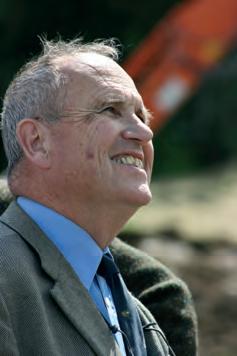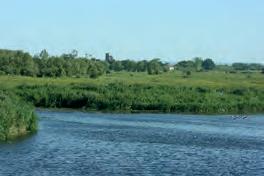





FREE

2
Places to findThe Leveller®
The Leveller® is now available in several supermarket outlets across the county. Please spread the word to friends and family. The paper will be available for one week from the 15 of the month at the following:
Bridgwater - Sainsburys
Bridgwater - ASDA
Burnham on Sea - Tesco
Chard - Sainsburys, Tesco
Cheddar - Sainsburys
Frome - Sainsburys
Glastonbury - Morrisons
Ilminster - Tesco
Dear editor
Shepton Mallet - Tesco
Street - Sainsburys
Taunton - Tesco, Castle Street
Taunton-Sainsburys Hankridge
Wells - Morrisons
Wincanton - Morrisons
Yeovil - Morrisons
Yeovil - Tesco
Letters to the editor
I took a walk around a new housing estate in Somerton a week or so ago and thought, how much has building design really changed in the last few decades of climate-change awareness?
None of the new-builds had solar panels and, despite the 2019 Government announcement to ban new natural gas boilers from 2025, the heating is by conventional carbon-emitting systems. I suspect the vast majority of new housing estates in the country are exactly the same.
Buildings are a significant source of carbon emissions, accounting for over a third of total global energy consumption. The technology is available and proven to reduce this significantly. Look at the environmental and financial savings that can be made by adopting passivhaus standards - for family occupants as well as the planet. Why are we taking so long to implement building technology that will make houses much more environmentally efficient, and with associated low energy running costs?
Brian Marshall Butleigh
Dear Editor
My partner picked up a copy of The Leveller at Taunton Tesco (only the 2nd time we have seen the magazine). We were blown away by the journalistic ethos and the wide range of interesting articles. We loved the way you got around some 'legal advice' in the Chard "bullying" story on page 36, identifying the 12 NOT responsible town councillors. Yesss!!!! Great thinking outside the box!
Guy Smith's bit on page 50 about the UK allowing a lot of doctoring of imported wine was very informative (and worrying), and his droll comment 'Local MP Rebecca Pow has been trumpeting our new found freedom to drink watered down wine as a Great British Brexit benefit' was very fitting, (over the years, I have written to Ms Pow asking for comment or action on certain concerns, and she has never failed to disappoint me; but I keep on writing, mainly to annoy her and to remind her of the job she's supposed to be doing...).
Your headline report on Fuel Poverty. Informative and scary, well done for bringing this to the fore.
We're looking forward to the next issue of The Leveller. Congratulations to all concerned for producing an excellent magazine.
Carole Brooks Taunton
Write to us:
If you would like to send us your views and comments on anything you read in The Leveller or anything related to our wonderful county, please write to the editor at: Leveller Publishing Group, Great Western House, Westover, Langport, TA10 9RB.
Editors’ Code
The Leveller® adheres to the standards set out in Editors’ Code. We operate a complaints procedure. If you wish to complain, please write to, or email the editor in the first instance (contact details as below).
Where to get your copy
The Leveller® is distributed on the 15th of the month via a network of local shops and pubs (see our website); we are very grateful for their support.
Our values
● Fair in our coverage
● Independent in our views
● Locally produced
● Promoting local enterprise
● Sensitive to the environment
● Careful with your data
Our Team
Editor: Andrew Lee: levellereditor@gmail.com
Staff Writers : Ancient Pistol: ancienpistolet@gmail.com
Writer at large: James Garrett
Sub Editor: Kate Roberts
Ad Manager: Ruth White levelleradvert@gmail.com
Ad Sales Executive: Juliet Barber levellermarketing@gmail.com
Art & Design: Rob Hutchinson
Advisory Board : Anthony Gibson, Paul Bell
Write to us at Leveller Publishing Group, Great Western House, Westover, Langport TA10 9RB
Advertise with us
We have a simple rate card offering ad sizes from an eighth of a page upwards. To request a rate card contact Ruth: levelleradvert@gmail.com or on 07973 758728
Juliet: levellermarketing@gmail.com 07544 737860
LevellerLive
For all our social media and online work we use the LevellerLive brand. You can find us on @LevellerLive on Twitter, Facebook, Instagram and YouTube.
For news between issues, go to our website: leveller.live
Copyright and
3
ownership All material, written and pictorial is © Leveller® Publishing Group unless otherwise stated and may not be reproduced, stored in a retrieval system or transmitted in any form, without prior express permission in writing. The Leveller® is an independent free newspaper published & distributed each month by the Leveller®
9RB.
columnists
Publishing Group. It is owned by Even Handed Licensing Ltd of Great Western House, Westover, Langport, TA10
Regular
Stephanie Harris Plender. Other contributors as credited. In-House Photos Andrew Lee, “Unsplash” or as per photo credit. Index to this edition Notices, letters and jobs Letters 3-4 Public Notices & Information 6 Jobs 36 Comment pieces Editorial 8 Political commentators 10-13 News Local News 14-24 Somerset News 1, 26-35 Business 37-38 Lifestyle My Somerset Home 39-52 Motoring 53-54 Culture/events 55-64
Alison Hayward, David Young, Guy Smith, Helen & Graham Walker, Jane Earthy, Jane Rodger, Lindsay Wright, Paul Adamson,
Next issue dates: Copy deadline 28 August Publication date 15 September

Dear Editor
I thought I would point out a correction needed in The Leveller, 15 June issue no. 152. The article “King’s coins for kids” refers to the wyvern flag. The county flag for is the dragon, often pictured holding a mace (the sign of learning). The county logo on the new Somerset Council heading is that of a dragon. Though it was a wyvern on the flag of the 43rd Wessex Division during World War Two.
Kind regards
Billy Mear
Yeovil
Ed says: Yes, mea culpa. The article should have referred to a dragon not a wyvern. Our thanks to Mr Mear for writing in and pointing out the error of our ways!
Sir,
Returning on Wednesday from town to my car in Tesco carpark I had a fall and found myself unable to get up. The first person on the scene said she would get me up which she accomplished with obviously practiced ease and she did indicate that she used to work in a care home hence the practice. To my shame however I did not ask her name which I regret and am asking if you can spare me the space to express my thanks to her through the medium of the Leveller in the hope that she will possibly see it. It was clearly my luck to be found by such a person and the lady deserves acknowledgement.
Yours faithfully
Brian Knights
Dear Editor
Treacle Eater very much enjoyed dancing in both Somerset and Dorset again this year.
I would be grateful if you could kindly include details of the free North West Morris Dancing workshops we are running again this year as follows:
Treacle Eater Clog will be holding free North West Morris Dancing ‘Taster sessions’


7.30pm Mon 18 September at the Scout Hut, Blackberry Lane, Sherborne DT9 4DE.
7.30pm Mon 25 September and Mon. 2 October at Rimpton Village Hall, Rimpton BA22 8AH
A warm welcome awaits no booking required.
Information from: Jenny 07974 590927
If you require any further information, please do not hesitate to contact me.
Best wishes
Jenny Hunnisett Publicity Officer Treacle Eater Clog
Following our piece about Bridgwater Cllr Richard Morgan last month, Bridgwater Labour wrote to us to explain the position: "I know Rich doesn't want this to drag on, which is why he's still posting about it, but it really isn't a mystery. National Labour Party temporarily suspended him while they investigated an anonymous complaint. That meant he temporarily had the whip withdrawn. To support him the Local Party followed procedure to cooperate with the investigation, which we were sure would see him exonerated, as explained the minor sentence didn't breech the code. This meant removing him temporarily from the 2 politically appointed posts (pfh transport and climate triad member) and temporarily putting 2 Labour members there. Region required this. To make this change we called a 5 minute council meeting. The only was it could be done. When the enquiry would have been complete and Rich exonerated we would have reversed this. Remember we had only just appointed Rich to these 2 posts a month previously so we wanted him there. Rich now leaving the Party is a shame because it means he won't face that enquiry and be exonerated and it means he can't take a post in a Labour run council. However, he remains on all other committees and doubtless will play the same role as he has done since being elected, representing his electors and fighting for the survival of the planet."
Brian Smedley Bridgwater
4 Letters to the editor

5 Advertisements
You should be able to get details of services and meeting dates via the contact details for your local council below:
Town Councils
Axbridge Town Council 07884 264033
https://axbridge-tc.gov.uk/
Bridgwater Town Council 01278 427692
Bruton Town Council 01749 813014 townclerk@brutontowncouncil.go v.uk
Burnham on Sea & Highbridge Town Council 01278 788088 townclerk@burnham-highbridgetc.gov.uk
Your Council Contacts

Castle Cary Town Council (01963) 359631 town.clerk@castle-cary.co.uk
Chard Town Council 01460 239567
Crewkerne Town Council 01460 74001
Dulverton Town Council 01398 324561 clerk@dulvertontowncouncil.co.uk
Frome Town Council 01373 465757 info@frometowncouncil.gov.uk
Glastonbury Town Council 01458 831769 office@glastonbury.gov.uk
Ilminster Town Council 01460 52149 town.council@ilminster.gov.uk
Langport Town Council 01458 259700 office@langport.life
Martock Town Council 01935 822891 or 07506 286382 clerk@martock-pc.gov.uk

Minehead Town Council 01643 707213
info@mineheadtowncouncil.co.uk
Shepton Mallet Town Council 01749 343984
info@sheptonmallet-tc.gov.uk
Somerton Town Council 01458 272236
town.clerk@somertontowncouncil.go
v.uk
Street Parish Council 01458 440588 street.parish@street-pc.gov.uk
Watchet Town Council 01984 633344 townclerk@watchettowncouncil.org
Wellington Town Council 01823 662855
info@wellingtontowncouncil.co.uk
Wells City Council 01749 673091 townclerk@wells.gov.uk
Wincanton Town Council 01963 31693
info@wincantontowncouncil.co.uk
Wiveliscombe Town Council 01984 631914 or TownClerk@wiveliscombe.com
Yeovil Town Council 01935 382424 ytc@yeovil.gov.uk
Somerset Council Office hours (8.30-5.00) service: 0300 123 2224
There’s no email contact for the council
However there is a web page which allows you to report specific items to obtain information or make payment.Go to: https://www.somerset.gov.uk/contact-us/
The Somerset Day
15 August
Sunrise 5.58 am
Sunset 8.31 pm
15 September
Sunrise 6.46 am
Sunset 7.25 pm




Sky Diary by Paul Adamson
Moon Phases
New 16th August / First Qtr 24th August / Full 31st August / Last Qtr 6th September
Planets
With Venus and Mars lost in the Suns glare our attention turns to the gas giant Planets being Saturn which is at its closest to Earth when it reaches opposition on the 27th of August and Jupiter which is much brighter and rises before 11pm. Venus reappears at the end of August around 5am shining brightly in the East.
Constellation
There is a swan an eagle and a harp high over head at the moment being the Constellation of Cygnus, Lyra
and Aquila. These Constellations contain the bright Stars Deneb, Vega and Altair the first three Stars to appear at dusk which form the asterism of the famous Summer Triangle.
Celestial Events
On the night of the 12th/13th August with the Moon out of sight we should have a spectacular display of the Perseid meteor shower then on August 31st the biggest and brightest

Somerset Stargazers monthly meetings are on the last Wednesday of the month except December for details please contact For details visit: somersetlevelsstargazers@hotmail.com
6 Public Notices and information


7 Advertisements
An inconvenient truth
For some time now, there has been a belief across most of the mainstream political parties, that we do not have enough houses in this country. The arguments for what we build and where may vary from party to party, but all are pretty much agreed on the fact that there is a shortage.
The problem they are all trying to fix, is the almost daily rise in house prices making them unaffordable for many, if not most, people on average incomes. The theory goes that price is a function of supply and demand. If demand is increasing then price will increase, unless supply is increased too. If supply grows faster than demand then prices will come down.
That is the economic theory. Which begs a question. Why isn’t it working? Governments keep setting targets for new housing and missing them. The target of choice for the Conservatives is 300,000 new homes every year. But even though the targets are missed, supply is demonstrably outstripping UK demand; and yet prices stubbornly refuse to fall.
Meanwhile headlines appear almost daily suggesting a crisis. Recent examples include “Renters compete with 20 others in battle to find a home” and “Numbers in temporary accommodation in England hit record.”So is there a very real problem here? A long standing shortage of housing in the UK?
There isn’t…
Let’s start with the basic facts. The population of England is 56 million. There are 23.4 million houses in England. That represents an average total of 2.4 people per house.
Armed with those figures it is simply demonstrably untrue that we need to build more houses. We have more than enough already.
Carbon crisis
The important fact to grasp is that there is a real cost to building un-needed housing. At present, courtesy of George Osborne’s Uturn in 2016, new houses are not built to be carbon neutral. So, even when they are completed and occupied, they will go on emitting carbon and adding to the climate crisis.
Those are the ones already built. But the very process of building new houses is one of the biggest contributors to man-made climate change. Added to which, as we discuss elsewhere in this issue, because the vast majority of new-builds are on greenfield sites, every new housing estate deprives the nation of agricultural production. That in turn adds food miles to what we eat and depletes our food security.
The house-building industry is of course a strident voice demanding that we build more new housing. Inevitably, given the vast profits the house builders make. Last year Taylor Wimpey made £909m profit before tax, Persimmon just over £1 billion and Barratt £642m. It is in the interests of house builders to perpetuate the idea that we need to build more houses. It was lobbying from house builders that persuaded Osborne to abandon carbon neutral housing which was supposed to be introduced from January 2016.
While we can readily understand why house builders might want to carry on building homes whether we need them or not, for others there are more searching questions. The question politicians should be asking, is this. If we have enough houses, then why are people struggling to get on the housing ladder? Why are too many people not able to get a decent home of their own?
The problem is not the number of homes in England, it is the unequal distribution of the homes among the population. That leaves politicians with some difficult, but hardly insurmountable, problems to grapple with.
Second and empty homes
One of the biggest factors at play here is the number of people owning more than one property. Over 2.4 million people in England own more than one home. These are not people acting as commercial landlords, simply people who have bought more than one residential property. Banning the ownership of second homes would undoubtedly prove unpopular. But as Europe roasts and record temperatures are recorded around the globe, there comes a point when the impact of climate change has to be taken seriously. Is it time to consider banning ownership of more than one home? To do so would achieve two things. In the first instance it helps reduce the need for building houses. Houses that are only needed
because some people own more than one house. And secondly, by reducing the need to build new housing, it contributes to lowering carbon emissions.
A second serious contribution to our current housing problem is the number of houses that are simply left unoccupied. The Leeds Building Society calculated in February this year that there are currently 676,452 empty homes in England, of which 248,633 homes are classed as long-term empty properties, having been empty for over six months. Councils across England have tried various schemes to bring these homes back into use, with, as the numbers show, limited success. The fact remains they are part of our housing stock and could with the right “incentives” be made available rapidly. Certainly more rapidly than building new ones.
There is also of course, the small matter of empty shop units in town centres that could, perhaps should, be converted into housing. One thing that the Government is actively considering.
Foreign-owned homes
But there is also a problem that, despite leaving the EU, a significant number of houses are registered to overseas owners. Some 247,000 in fact. Many of these houses are registered to overseas companies whose ultimate ownership is opaque. New Zealand has found an innovative solution to the same problem that blighted their own housing market. In 2018 they banned foreign nationals from purchasing houses in New Zealand. If Parliament were to enact a similar law in Britain, there would be choices. Not only would the overseas purchase of UK homes be choked off in future, but we could consider forcing compulsory sales of property owned by non UK residents as part of the legislation. Which would increase our housing stock by more than we are managing to build in a year. One of the biggest barriers to having a home of your own is cost. And this is largely due to tenure. When social housing was sold off in the Thatcher years, often on the cheap, councils were forbidden from investing more money in replacement housing. As a result, council houses (today the required term seems to be “social houses”) are rare. And council houses offer the cheapest rentals to those who genuinely struggle to get onto the housing ladder. Private rentals simply offer the commercial rate.
Healthy returns from social housing?
Bizarrely, as councils were investing money in commercial property to make a return, it did not occur to them to invest in social housing. While many invested in commercial property at the top of the market (as The Leveller® warned at the time) and are now seeing large write-offs against their portfolios, social housing could represent a sound capital investment.
Persimmon built houses at an average price of £237,000 and an average profit of £66,000 in 2021. A council doing the same job could build a property at a cost of £171,000 and rent it out at £700 a month and still make a 5% return. In perpetuity. Meanwhile the going rate for a private three-bedroom house in Somerset is well in excess of £1,000 a month.
If more council houses were owned by local authorities, those same local authorities could offer cheaper homes to rent and still make a solid return on investment to plough back into council services.
If any new houses need to be built at all, if they were social housing built on brownfield sites to carbon neutral standards, they would be contributing to the solution at least, not simply adding to the problem. It would allow more people to be housed cost-effectively, while councils could invest for a return.
But what of those house builders left with nothing to do? The final part of the problem of housing, especially when looked at through the prism of climate change, is the fact that far too many houses are generating carbon either because they have been built cheaply or because they are in poor condition having deteriorated over decades or, in some cases, centuries. Which means the lowest level of efficiency that building regulations permit.
Government now needs to seriously consider a nationwide retrofitting programme to bring our housing stock up to a standard of carbon neutrality. Given the scale of that challenge, there should be more than enough work for house builders for decades to come. The one thing we do not need to do though, is to build more new houses.
8 Andrew Lee Editor 15 August 2023
Leveller® Publishing Group Great Western House Westover Langport


9
Left Page, Right and Over !
Left page
The task we set our commentators this month was on the face of it a simple one. "what lessons are there for the politics of Somerset from the Somerton & Frome by-election result?"
But it asks for serious analysis not to run away with political points scoring. Which always makes the answers that we get all the more interesting!
These are the politicians tasked with giving you an answer:
Left Page: Leigh Redman is a county, district and town councillor for Bridgwater and a Labour Party member.
Right Page: David Fothergill is a Conservative councillor for Monkton and North Curry. He is leader of the opposition on Somerset County Council (SCC).
Over The Page: Liz Leyshon is the Libdem County Councillor for Street and is Deputy Leader of SCC.
Green Page: Martin Dimery is the Green Party Leader on SCC and candidate for Somerton & Frome constituency


The Left Page by Leigh Redman
Let me start by wishing the new MP for Somerton & Frome all the best in her new role. I was a County councillor when Marcus Fysh was elevated from the council benches to parliament benches. I hoped that having seen how hard it was here, he might become an advocate for where he came from… That did not go well. It is good to be back doing this column, I do enjoy taking part. Speaking as leader of the Labour Group on Somerset Council, I will say that most of the responses I give to the questions are my own opinion. This month’s question is an interesting one, I think the bigger picture is more about, ‘can you learn anything from a parliamentary by-election in the current climate of politics?’ Politics is over-complicated by too many people, but, from the short time I have been around, I think the main lesson we can learn from Somerton & Frome, as I hinted above, is to keep it local. The main candidates in this by-election were very local, which is how it should be, the issues discussed on the door step and hustings were mainly local and led by the cost of living crisis. I did feel a little sorry for the Tory candidate, but only a little bit.
I think the people of Somerset have been disproportionately impacted by circumstances outside of their control. I have said it before, I believe we are in the big hole locally now, because of the actions of 13 years of Tory government and the actions started by the Tory administration in Somerset more than 15 years ago. Cuts, cuts, and cuts. Somerset was one of the first councils to took the Eric Pickles school of local government finance to an extreme. The level of cuts inflicted on Somerset people, heightened by a long period of frozen council tax and cuts in grants from central government, has devastated many of the services the council provides. By the way it is interesting that the government has finally woken up to the fact that a light touch in local government was wrong. Michael Gove launched the new Office for Local Government (OFLOG), after finally realising that the current ‘light touch’ is not working, something we’ve been saying for years.
The messages coming out of Somerset Council are concerning. The overspend of last year, the combining of 5 councils, the new finance system, the uncertainty for staff, costs for social care, the lack of confidence in the current government, are all coming together to make our short term future a lot more worrying.
I think we need to listen to the conversations heard on the doorstep in Somerton & Frome, build on our local agenda and try to meet the urgent need for our communities. We need to be making our case to government while we are getting ready for the next general election. The cost of living is having a disproportionate impact on those in our communities who cannot withstand it and the cuts are taking a toll on the areas of deprivation in Somerset. We need to find a way to rebalance, we need to build a better Somerset.


10
Right Page
by David Fothergill
Ok, so let’s start with the serious observations about lessons from the Somerton and Frome by-election.
It was always going to be an uphill struggle for the Conservatives in the constituency where the previous MP, who so many had put their trust in, left them without full representation for over a year. Added to that feelings amongst many towards the current national Government certainly didn’t help! Conservatives stayed at home or withheld their vote and the opposition supporters eagerly saw it as an opportunity to register a protest.
Credit to the LibDems for winning the contest but they threw everything at it including at least 17 leaflets, pulled in deliverers from across the Country and focussed on getting their vote to turn out with dozens of helpers on polling day. Those strategies work well in a by-election as we have seen at Tiverton and Honiton, North Shropshire and Chesham but become far more difficult to comprehensively implement in a general election.
Many would argue of course that this seat will disappear within 18 months and in reality, the outcome would make no difference to the Governments majority in Parliament. But I would argue that every vote in every election is important, and we misunderstand democracy if we start to feel some elections don’t really matter.
Allow me though to turn to lighter observations about the election and if you’ve never delivered leaflets or been a postman stand by for some insights!
Firstly letterboxes below three feet from the ground should be banned – they are absolute backbreakers! Secondly, those same letter boxes need to be regularly oiled and maintained so that they don’t resist opening or worse still snap shut.
Thirdly, silent attackers lurk behind some letterboxes- for the second time in recent elections I received a dog bite as I posted a leaflet, fortunately this time it didn’t draw blood and I didn’t finish up in A&E!
Fourthly, there is no logic to how some roads and estates are numbered. But worse still are whole villages (and I live in one) of houses with only names. It takes twice as long to deliver addressed letters!

Finally and this is returning to a serious point, in an average day of delivering I find at least two doors with keys in them including the car keys for the car parked on the drive but more worrying are the number of wide open doors when it is obvious no-one is in!
By-elections will come and byelections will go, those letter boxes, dogs, numbers and house names will still be with us. But do at least learn this lesson from Somerton and Frome and please take your keys out of your door and make sure it is fully closed!



11
Right page
Over the page

 Over
Over
the Page
by Liz Leyshon
"What lessons are there for the politics of Somerset from the Somerton & Frome by-election result?"
Lessons, political and otherwise, continue throughout our lives. No matter how successful the election campaign and size of the majority, there are always learning points, individually and collectively. Those of us delivering leaflets and knocking on doors regularly commented on the huge geography of the Somerton & Frome constituency, but that’s nothing compared with the size of Somerset Council’s footprint.
The differences in the natural and built environment across the market towns, villages and hamlets are marked and very significant. I realised just how many different personal circumstances there are for us to consider as the administration of Somerset Council. Again and again residents brought up their huge concern about access to GPs, access to NHS dentists and waiting time for ambulances. I don’t think there’s any difference between rural and urban – the whole system feels desperately short of clear planning and adequate funding. I know that’s more national politics than local, but local authorities are now part of the Integrated Care System for Somerset. Then on to the politics lesson. It feels as if politics has been stood on its head, by Brexit. It’s always the elephant in the room, and it’s an important elephant that will have impact for decades if not generations to come.
Where we might have expected a Labour vote, we often now see Reform UK or UKIP. When I was told that Brexit has not been completed and the benefits not realised yet, hence a Reform UK vote, I just kept quiet. Where we might have expected a Conservative vote, we are now welcomed, or we see quiet faces that are likely to stay at home and abstain from the vote.
Another lesson for me was something that I’ve been told before but had not fully recognised. The population moves far more often, and far more widely than we may expect. I canvassed in a village where my family lived for 40 years. It was delightful to see old friends yet there were many people who have moved to the village since we left in 2014.
I found it notable that younger people were really pleased to see us when they opened their door. It’s a generalisation but they clearly warmed to our demonstration of hard work and commitment. That level of commitment from Sarah Dyke and the impressive by-election team is necessary in so many places at this most challenging of times.
A Lib Dem by-election campaign is a clear demonstration of commitment, dedication, and hard work.
Finally, a lesson on the importance of always clearing up. When the latest Lib Dem celebration was complete and the confetti cannon ‘fired’, one of my Somerset Council colleagues, Adam Boyden, made sure all the confetti was swept up. Well done and good luck to Sarah Dyke MP.


12
Green
Page by Martin Dimery
Many thanks to those who voted for me in the Somerton and Frome by-election. When I saw the final tally of Green votes, I confess to some disappointment. It was barely more than was accumulated in last year's Somerset Council elections by our top candidates in Frome wards alone. The following morning it was relayed to me however, that the BBC had identified our 10.2% as highest ever vote percentage by any Green candidate in a UK by-election. This put the achievement in perspective.
It was clear from early in the count that most of our strong Green vote in Frome had stayed loyal, but there was an undeniable tactical swing to the Lib Dems which grew considerably in other parts of the constituency. In the end, our third place, ahead of Labour, proved to be a record- achieving result and something on which to build. Clearly, tactical voting determined the result, but did all of those Liberal Democrat leaflets, urging people not to vote Green make any difference? As irritating and persistent as they were, they actually began to work in our favour. On election day, I found myself defending an innocent Lib Dem campaigner who was being berated by an aggressive member of the public at the polling station for the avalanche of paper thrust through his door.
There were other, less ethical, election tactics too. We grew tired of replacing posters that had been torn down and reading inaccurate bar charts distorting previous election results (see Leveller Confidential). Worse was the “false flag” letter written by a former Green voter, urging the public to vote Lib Dem, which was posted through local letter boxes. Many people missed the legally required but microscopic ident at the foot of the page which confirmed that the letter was published, edited and distributed by the Liberal Democrats. We were inundated with messages from voters asking if the Green Party really was advising people to vote Lib Dem, and many were truly appalled when recognising the flyers’ duplicitous intent.
Despite the above, I congratulate Sarah Dyke on her resounding victory. I get on well with Sarah on the Somerset Council and I’m sure she will be a hardworking MP. She was always the front runner in claiming the anti-Tory vote. She would have won without her party’s well -resourced chicanery. With boundary changes, I’d be surprised to see any of my recent opponents competing in the new Frome and East Somerset constituency next year. There, the Green Party will start on advantageous terms.

This time, no other party will justifiably spin the idea that “Greens can’t win here”, although I expect at least one will try.



13 Green Page
DerekYeomans
It is with great sadness that we report the passing of Cllr Derek Yeomans. I first met Derek to interview him in the early days of The Leveller®. He slapped a voice recorder down at the start of the meeting: “so you lot won’t misquote me”!
View From Langport by Sean Dromgoole View from the Count

It seems to me that that was very Derek. Straight talking, down the line honest. Good qualities for a man who cared deeply about public service. He spent more than 40 years in the Merchant Navy, Fleet Air Arm, and Royal Fleet Auxiliary. When he made Curry Rivel his home, he served on the Parish Council as a councillor and as Chair of the council. But, while he served as parish councillor with distinction, he was also a County Councillor for Langport & Curry Rivel for 16 years and as District Councillor for Burrow Hill Ward. As if that wasn’t enough, he was Chair of the Somerset Waste Partnership and even after he retired as a District Councillor he still served on the South Somerset District Council Audit Committee. He was respected by those who did not agree with him, as much as by those who shared his views. He carried a deep sense of integrity and as Chair of Somerset Council, Councillor Mike Best put it: “Derek Yeomans …..worked for his community and the greater good of Somerset. I served with him for many years on South Somerset District Council especially on the Audit Committee and witnessed first-hand his great attention to detail and passion to get things right.” I don’t think we ever misquoted him, because I’m sure Derek would have told us if we did.
New players needed!
The way the Ashes Tests played out in such dramatic fashion this summer excited a nation and proved the love of cricket is as vital and hearty as it ever has been. With a women’s Ashes series running alongside too, the game is also more inclusive than ever. The grass roots of the game of cricket are essential for nurturing young talent and evolving a love of the game at all levels and for allcomers. So, it is sad to report that Huish and Langport Cricket Club has had to temporarily withdraw from the Somerset Cricket League because of a lack of availability of players for its Saturday senior team matches.
The Club is older than many county sides, having been in existence since 1839. Let’s put a bit of context on that, Somerset County Cricket Club was only founded in 1875 and didn’t join the County Championship until 1891.
It is not only a venerable club, but Huish and Langport boasts one of the most picturesque grounds in the country. Things have not always gone to plan in the past and in May 1913 when known simply as Langport Cricket Club, the team was all out for 0 in its first innings against Glastonbury – off just 27 balls. Langport’s row of ducks even made headlines in Australia, where the Evening Telegraph of Queensland reckoned it was a record for the game. The Club has done a lot better since then. But a club is nothing without players. Now they are appealing for new blood for adults, youngsters – indeed anyone aged 12 and over. Secretary Toby Strang said: “We offer people of all ages the chance to participate in the sport in a welcoming, friendly environment. Looking ahead to 2024 we certainly look to re-entering the league which starts in early May. We also have a Sunday team who play friendly matches against local clubs. In addition to our senior sides, we actively work with local schools, endeavouring to get participation of youths back at this local club, we have recently enjoyed coaching a group of students from the local Academy on Wednesday evenings.”
Please help them out and give the Club the hope of continuing a fine tradition. If you are interested in playing, or just supporting the Club take a look at the Club website –huishlangport.play-cricket.com/home
Readers of The Leveller®, erudite and aware as you all are, will hardly have missed the fact that on 20 July we had a by-election in Somerton & Frome constituency. One of the great pleasures for a politophile like myself is going to watch the votes be tallied. This is where the wheat is separated from the chaff. Ideas and people that pass Somerset muster can fly, while the bluster and empty gestures of others leaves them quivering unsupported on the floor. This time the count was held in the central hall at the Bath and West showground which perhaps oddly, is not in the constituency. In terms of mechanics the sealed boxes are brought in from each of the polling stations. The last of the boxes arrived by about 10:45. The room is laid out so that the counting tables form a continuous perimeter. The all-important counters on the inside and observers and guests have to stay on the outside. Each candidate/party is allowed ten tellers and a couple of guests. Each box is verified, which involves confirming that there are the same number of ballot papers coming out of the box in the hall, as were recorded being put into it at the Polling Station. The sorters take this opportunity to put all the papers the right way up. As they do this, experienced old hands decend like flies on a corpse. They can, by peeking, keep their own tally of how many votes each candidate got from each polling district. The first two I watched were Langport and Frome and it was immediately obvious that Sarah was going to win and that the Greens were going to do much better than previously.
As this casino like multi-drama is playing out across the tables, the grandees are doing their grand tours around the observation zone. If you’ve been meaning to have a word with Bill Revens, or indeed David Forthergill, about supporting some local initiative – this is just the place to catch them. One much missed grandee was the delightful Mike Lewis with whom I had many a giggly chat after a polling midnight. His loss is felt deeply across Somerset’s political spectrum.
Fishing in this same “observer” pond are the journalists who are scurrying about and trying to find stories and interviewees. If caught, you find yourself waiting for a minimum of 15 minutes, next to a presenter you half recognise, in front of a light that hurts your eyes, only then to be asked two strangely random questions because of some half-baked theory they have been debating in the studio. Best avoided.
The counting of the votes part is relatively fast, and they pile up the completed bundles on a huge table in the middle of the protected area behind the counters. They put them in bundles of a thousand. Even if your telling was way off, you can quickly see the truth emerge. 21 bundles for Sarah (which Betfair could have told you 4 weeks ago), 10 for Faye (who, in my humble opinion, put not a foot wrong), 4 bundles for Martin the excellent Green. All the others lost their deposits of £500.
There was one candidate group who barely spent anytime at all in the observer area, preferring to huddle in the closed café next door. Perhaps this was because the group contained not a single Somerton & Frome constituent, and, with the exception of a well-liked councillor from Bridgwater, knew not a soul in the room. Perhaps it was borne of a certain anxiety to avoid your humble correspondent who had in past had been their candidate? Their campaign had spectacularly failed to “Read the Frome”, and they had shed four of every five votes their party had earned last time. “Whereof one cannot speak, thereof one must be silent,” or so I have been advised by my anger management councillor.
Putting my non-local difficulty to one side, it is to Somerset’s great credit that politics here is collegiate, informed, funny and kind. If as I leave it, I have left it stronger in any of those virtues, whatever stripe is in the ascendant, then my otherwise glory-spared career may have done something good. Long may it remain so.
Sean Dromgoole was formerly the labour candidate for Somerton & Frome at the General Elections of 2017 and 2019.
14 Local News - Langport, Somerton and villages


15
Sharp dressed man (or woman)
Once upon a time, not having a tie on would get you thrown out of quite a few establishments. When we first started reporting on local councils, the Editor would go along in a jacket and shirt and collar. Then along came dress-down Friday and – later still – the pandemic. Today, a requirement to be smartly turned out is increasingly rare. But not so for the members of Somerton Town Council.
At their July meeting, councillors passed a resolution on how councillors should be turned out in future. No, this is not an April fool. All councillors are expected to wear smart casual clothing. No shorts or sports clothes are permitted to be worn, with the exception of trainers (shoes).
• Hats of any kind are not to be worn when attending council meetings.
• Any councillor unable to comply with the dress code policy for a disability or health reason will be granted a dispensation for all meetings for as long as the condition applies.
• The chair of any meeting has discretion to excuse a councillor from complying with the dress code on condition of a satisfactory explanation being provided to the chair.
The new rules apply to full council meetings, council committee meetings and any other event where councillors are acting in an official capacity. So watch out for your local councillors. Whether or not they stand out from the crowd, they should at least be natty dressers…
All change again at
As another term finishes at Huish Episcopi Academy, there are more changes ahead. The school was put in special measures at the end of 2022 after being graded “Inadequate” by Ofsted, but it now seems that it is well and truly on the road to recovery. It formally joined the United Learning multi academy trust on 1 June.
Nat Parnell was brought in as interim Principal to turn things around. That appointment ended with the summer term. Mr Parnell describes his tenure at the school in glowing terms: “I can honestly say I have grown to love and respect this community in my time amongst you and I will be sad to leave.”
A new Principal has already been identified for the school. Mrs Katie Boyes has been Headteacher at Queen Elizabeth’s School Wimborne, Dorset for just over four years and was at the school in various roles for more than 12 years. The school was rated “Good” at the last Ofsted inspection – albeit that was back in 2017. She starts as Principal of Huish Episcopi Academy in September.
Town Council turnover
Another month passes and there has been another resignation from Somerton Town Council. Stephen Tate, who is also a town councillor on Langport Town Council gave his notice. As a result, the townsfolk of Somerton must decide if they want an election to find a new councillor, or if they are happy to allow co-option.
Under Section 87 of the Local Government Act 1972 notice of the vacancy has been published. If you want an election, then 10 electors will have to make a request to the Proper Officer of Somerset Council at The Council Offices, Brympton Way, Yeovil, Somerset, BA20 2HT by Wednesday 16 August 2023.
If you don’t ask, then co-option will follow!
Lorries on Pesters Lane
Residents along Pesters Lane have had their own trials with traffic volumes this year. Added to the problem is the fact that the narrow lane, complete with speed bumps, occasionally gets HGVs using it. On 18 July a large articulated lorry attempted to climb the lane and got stuck. The Police had to intervene to help the driver. In the end three officers had to help, having to close both Pesters Lane and West Street while the lorry was escorted on to Jubilee Park. Somerton Town Councillor, Phil Flowers, commenting on the incident said only the Police can help in these circumstances, local councils cannot get involved. He believes that too many lorry drivers are using phone satnavs which do not account for weight
Kirkham Street Field - an update
The Kirkham Street Field Community Trust was formed in 2019 in an attempt to save Kirkham Street Field, the last bit of publicly accessible green space in the centre of Somerton. The green space is around one and a half acres of meadow that was due to be sold by Somerset Council, the owner, to offset the cost of building a new Junior School for the town at Northfield.
Since it was formed, the Trust has attempted to raise money to save as much of the Kirkham Street Field as possible and explore creative ways of allowing public access and use of the space. It managed to get the field recognised as an asset of community value.
Careful planning
At a public meeting last year, a team led by Sam Hampson and Anna Anderson presented different ways in which the field could be developed as two-thirds community green space, with one-third residential. The presentation was visual so that the public could see how their ideas could work here on Kirkham Street Field. It met with a favourable reaction from the community members present. It was then decided to approach the planning authority with the support and expertise of a local professional planning consultant, to establish how these ideas could best be presented in ways likely to gain planning consent. A more specific public consultation would then take place to ensure community involvement.
Anna and Sam are themselves bearing the full costs of their professional advisers and the costs of the public meetings to discuss their proposals. The Trust supports their exploration of these ideas and the trustees are in regular contact with Anna and Sam. The local planning authority has now been approached via the planning consultant, with the scheme for the field area split between residential one-third and two-thirds community green space. In view of the changes from South Somerset District Council to the Somerset Council Unitary Authority this process has, of necessity, taken longer than usual.
Anna and Sam’s team, together with the local planning consultant, have had some initial engagement with the Council Planning Officers and are undertaking the assessment of planning requirements. The Trust hopes to be able to report more progress by the end of the summer and thanks Somerton residents for their patience and support.
No thanks we have our own!
Somerset Council are offering towns and parishes throughout their patch the opportunity to investigate setting up 20mph schemes in their communities. Somerset Council are particularly keen to have such schemes covering areas outside schools and in town and village centres.
Implementing 20mph schemes, the council reckons, will cost in the region of £15,000 per scheme. So villages and towns were offered the chance to pay a non-refundable deposit of £500 to get data on traffic movements. That would help communities decide if implementing a scheme would be worthwhile.
Somerton Town Council discussed the idea at their July meeting. However the proposal was rejected, with all councillors voting against except Tim Kerly who abstained because he was a Somerset Councillor.
Cllr Phil Flowers explained that all of Somerton town centre, except Behind Berry, is already covered by a 20mph scheme. Added to which Cllr Flowers believes the town council already have the data which is collected by the town’s Speed Indicator Devices (SiD)s and the Community Speedwatch Team.
The data collected by the SiDs is public information and available to anyone who wants to see it. You can find the information at www.somerton-csw.uk/
restrictions placed on roads such as Lower Somerton and Pesters Lane.
Speaking to The Leveller®, resident Ginny Facey explained: “about 18 months ago Martin Evans from SCC actually visited the site and spoke to one of our neighbours about the dangerous junction at the top of Pesters Lane. He said he would put together a plan to make the junction safer and improve the signage. We have never heard anything.”
16 Local News - Langport, Somerton and villages


17 Advertisements

It’s your money, find out where it goes
Shepton Mallet Town Council is to shed some light on the way it goes about setting the budget for the year ahead. The council’s financial year runs from 1 April to 31 March and the money it has to spend is raised from local taxpayers via the precept. This forms part of your council tax bill. Because of that, taxpayers often focus only on the total and the fact the bill comes from Somerset Council. Yet it also includes substantial amounts for the Police, Fire and Rescue Service and town and parish councils too.
Shepton Mallet raised a tax of £715,750 for the financial year 2023/24. So if you are a resident of the town you might well want to know how the amount is calculated and what the money is used for. With that in mind, the Town Council will hold a Budget Workshop in the Library on Tuesday 17 October 2023, with a further drop-in session there on the afternoon of Wednesday 18 October. The idea behind the Budget Workshop for the public is both to help them get a better understanding of the budget and council tax but also to have some input into the Council’s financial conversations for the coming year (24/25).
Town Clerk Claire Commons told The Leveller®: “This is something I developed at a previous council. Having worked out what worked and what didn’t, I recommended to the Council that we implement it here. It is natural that people won’t understand what makes up a budget, what the difference is between precept and council tax, what the difference is between the town council and Somerset Council. This will hopefully all serve to inform and engage the community so that they can influence how the council shapes its work over the coming years.”
For more information, visit www.sheptonmallet-tc.gov.uk/budget
Frome saves 4 tonnes
Somerset Council launched two pilot projects in Frome in May this year to expand the range of plastics that could be recycled. The campaign focused on flexible plastics (things like the wrapping that a loaf of bread might come in) or plastic sweet and chocolate wrappers.
The scheme is part of a campaign run in partnership with SUEZ Recycling and Recovery UK. Nine local authorities joined the scheme; Somerset was one.
Only homes invited to join the scheme in each of the trial areas could take part. In Somerset the trial was restricted to 3,600 homes in Frome. Residents were asked to put their flexible plastic wrappings into a special blue bag and leave it out for collection.
It seems to have been a success as between May and the end of July more than four tonnes of plastic wrappings were collected. The aim of the trial is to demonstrate the capacity to expand current recycling schemes to take in more products.
Residents who are not part of the trial can still recycle their plastic bags and wrappings at certain local recycling points. These are often in supermarket car parks. Recycle Now’s search function can be used to find locations. To find your nearest site, google “recycle now” and follow the links.

Operators travelling backwards
Train operators are extending the time available to respond to the consultation reviewing how tickets are sold at stations by an extra five and a half weeks. Reaction to the plans – which would see all the ticket offices at Somerset stations closed – have been robust, to put it tactfully.
A nationwide outcry over the plans came with suggestions that blind and partially sighted groups and other disabled passengers were not properly consulted on the changes. This could lead to legal challenges if the proposals were to go ahead.
The backtracking by the operators means that passengers will now have until 1 September to complete the consultation, which they can do online on their local train company website or by visiting www.transportfocus.org.uk or Londontravelwatch.org.uk. Op erator information about the consultation will be made available in accessible formats.
Jonathan Barter, Taunton Labour’s Parliamentary Spokesperson, wrote to GWR to: “express my deepest concern around proposals to close train ticket offices in Somerset. Under your proposals, Somerset would no longer have a single ticket office which I fear would be a severe detriment to many customers. Great Western Railway have failed to satisfy concerns that this will have a serious detrimental effect on many rail users.” Gideon Amos, LibDem Parliamentary candidate for Taunton and Wellington focused his attention on the proposed closure of Taunton Station ticket office. On 11 July he launched a campaign to keep the ticket office open with a public meeting and a petition. Two weeks later he had more than 450 signatures opposing the planned closure. Wasting cash and care
In the case of Taunton, which has just spent several million on a new ticket office and entrance on the south side of the station, closure would also represent a considerable waste of money. Heart of the South West Local Enterprise Partnership provided a £4.6m contribution to the various station improvements from their Local Growth Fund.
Meanwhile, Cllr Tim Mander was rousing opposition to the closure of the ticket office at Bridgwater station: “Bridgwater is a growing town and the Town Council wants to see rail services increased and improved. The station building is a fantastic asset and it’s absolutely crucial that we not only maintain but increase the ticket office opening hours. Having station staff on hand to answer queries and reassure the public and train passengers is fundamental to operating a successful and sustainable rail service. Stripping out staff and relying on passengers using online or machine ticketing excludes the vulnerable, elderly and disabled and is not the way to run a public transport system”.
The Somerset Bus Partnership also weighed in on the issue saying: “The closure of ticket offices will have a negative impact on all rail users, and especially the disabled. It is not just about tickets: staff at ticket offices are often the only point of contact for people arriving at a station who need assistance. They help carry luggage, provide information and advice, deploy ramps, take cash payments and unlock toilets. Rail companies have been trying for years to de-staff stations and remove guards from trains, in pursuit of profit. Please help to fight the de-humanising of rail services by completing the survey. And, remember, while ticket offices remain open, use them!” Which sums things up pretty well.
18 Local News - Towns


19 Advertisements

Taunton breaches court order
A Taunton woman who had been banned from keeping animals has been found by an RSPCA inspector to be involved in the keeping of two horses. In 2017 the same woman had pleaded guilty to failing to meet the needs of dogs, cats and birds in her care. Taunton Magistrates Court disqualified her at that point from keeping any animal for a period of 10 years.
Earlier this year, however, Cheryl Harris aged 32 from Norton Fitzwarren was reported to the RSPCA for being involved in looking after horses. RSPCA Inspector, Jo Daniel, followed up on the case and as a result Ms Harris faced charges that “between 11th June 2021 and 13th October 2022 in the vicinity of Taunton, you were participating in the keeping of various animals including two horses namely a bay thoroughbred known as Dobby and a grey thoroughbred known as Star.”
She failed to attend her hearing at Taunton Magistrates Court on 23 May, and was found guilty in her absence. Appearing before the same court on 18 July, she was sentenced to a 12-month community order with 80 hours’ unpaid work and 20 Rehabilitation Activity Requirement (RAR) days. She was also banned from keeping any animal for another 10 years and ordered to pay £750.
Speaking after the sentencing, Jo Daniel said: “It is important for people to tell us if they believe someone has breached a ban. We depend on the public to be our eyes and ears and we take breaches of bans very seriously – as do the courts.”
Bridgwater’s new blue plaque
On Sunday 2 July a new Bridgwater & District Civic Society blue plaque was unveiled, to mark the former burial ground of the Quakers and Wesleyan Methodists. The burial ground lies between Albert Street and The Broadway to the south west of the town centre.
The Bridgwater & District Civic Society runs its own Blue Plaque Scheme, modelled on the original London scheme which today is run by English Heritage. A blue plaque is a permanent sign installed in a public place, serving as a historical marker to commemorate a link between that location and a famous person or event.
The Quaker burial ground In Bridgwater was in use from 1721. The last known burial was in 1917 and the ground was handed over to the council in 1935. The Wesleyan burial ground (the half further from the Broadway) was added in 1830. The last known burial was in 1912. There are 74 known Quakers, and 142 known Wesleyan Methodists buried here, with an estimated total of between 400 to 500 people resting in the ground.
Among those buried there are:
● Thomas Hutching, a Bridgwater builder, responsible for the construction of the Cornhill Market House including the dome.
● The Clarke brothers (cousins to the shoemakers): Thomas Clarke was a scientist and botanist, who built Halesleigh Towers (Quantock Gateway), while his brother John Clarke was an inventor, who devised an early mechanical computer that could generate Latin poetry! John Clarke also invented a waterproof cloth, an invention he sold to Mr Macintosh.
● Francis James Thompson was mayor in 1883 and he founded the Thompson ironmongers, which survived right up until a few years ago in Mount Street.
● There’s also Margaret Sturge, one of the earliest female historians of Bridgwater.
The Civic Society was keen that this remarkable plot should be properly commemorated and signposted, as an important addition to Bridgwater’s Blue Plaque stories.
Another Wells Gem
Wells is the sort of city which boasts iconic ancient buildings. There’s the unforgettable majesty of Wells Cathedral and Britain’s oldest complete street, the mediaeval Vicars Close. Tourists flock to both every summer. But away from the well trodden tourist trails, the city has other hidden gems. How many people even notice the ancient Wells City Almshouses as they queue up for access to the Waitrose car park?
The oldest almshouses are tucked into the corner of Chamberlain Street and Priest’s Row with another close of almshouses along the east side of Priest’s Row. The earliest of the almshouses was gifted to the city in 1424 through a legacy from Nicholas Bubwith the Bishop of Bath and Wells and also Treasurer to King Henry IV. If the frontage of the almshouses on Chamberlain Street is not the most glamorous, the setting behind St Cuthbert’s Church makes up for it.

Chapel restoration
Next to the row of almshouses is the Bubwith Chapel and a Guild Room which was once used for city council meetings before Wells Town Hall was built. Wells City Almshouses launched a project last year to raise funds to restore the chapel and turn it into both a visitor centre and a community space for the city. It will continue to be a place of worship, but also provide a warm space for older residents to meet. The renovated chapel will also play host to concerts, recitals, lectures, workshops, seminars and rehearsals. All of which should mean that what was once something of a hidden gem, will become much more visible and another asset attracting visitors to the ancient city.
The road forward for the project has not always been an easy one. Getting planning permission proved to be something of a struggle, but eventually Mendip District Council planners agreed a scheme that worked for Wells City Almshouses too.
Early fundraising activities included an Isle of Wight Coastal Path Walk and a range of small and charitable donations. That brought the total up to £45,000. Since then, donations or grants have been received from Mendip Communities Fund, The Blair Foundation, and Wessex Water. Now the icing on the cake has been a major award from the National Lottery Heritage Fund. They have granted £158,490 to the project, which means that building work on the project can get underway soon.
Yeovil to get diagnostic centre
Yeovil is to get a new Diagnostic Centre, one of five diagnostic centres that will be developed in the South West announced by NHS England today. The Yeovil Diagnostic Centre will be a modern stateof-the-art stand-alone facility adjacent to Yeovil District Hospital with the capacity to provide more than 70,000 diagnostic tests and outpatient appointments a year. It is expecte dto be open to the public by the end of 2024
Open seven days a week, it will provide radiology, endoscopy, cardiology and audiology diagnostic tests.
This follows on from the success of the centre opened in Taunton on the site of the former Fire Service HQ. When that centre opened in September 2021, 7,737 Somerset NHS Foundation Trust patients were waiting for a diagnostic test and 45.8% of them were waiting longer than the national 6-week standard. The latest figures, for March 2023, show that the percentage waiting longer than the 6-week standard has fallen to 12.5%.
20 Local News - towns



21 Advertisements


Watchet worries
The Marine & Property Group (MPG) is based in Cardiff and in 2021 it set up a company called Watchet Marina Limited. That company took on the lease over Watchet Marina from Somerset West and Taunton Council, which is now of course Somerset Council.
Since January this year we have been writing about the group because of the lack of clarity over its funding and the possibility that the group might fail. This would leave Watchet Marina and harbour without a tenant to run and manage a key asset. Given the impact on local businesses from the closure of one of the main roads into Watchet, this makes the situation in the harbour even more pressing.
The view of Somerset Council has consistently been that there is nothing to worry about and they have full confidence in the MPG.
On 6 May this year the MPG entered administration. Several other group companies are already in administration, others are facing winding up petitions from HMRC. However Wachet Marina Limited is not itself in administration at the moment.
On 23 June 2023, the administrators issued their report. It does not make for happy reading. The administrators believe that the £1.8m of arrears owed to HMRC at the end of COVID has now increased significantly. The administrators say they were called in by finance company TAB because they felt the MPG was under threat of imminent liquidation. The group, say the administrators, is under capitalised, loss making and has survived by deferring payments to creditors, including staff.
It doesn’t help that the administrators noted that accounts were not up to date due to “the lack of a functioning finance team.”
So what will the administrators do? The first goal for any administrator is to try and enable the company to be rescued as a going concern. The administrators believe this is not viable. Somerset Council take note!
The current plan therefore is to try and get a better result for creditors than if the company was liquidated and wound up. First priority has been to try and realise assets to pay the money owed to staff. This the administrators say amounted to £146,570. The administrators are trying to organise the sale of the nine subsidiaries that own marinas. That includes Watchet, albeit the administrators say Watchet Marina Limited is loss making. Whilst a sales process is being prepared, progress is being hampered by the lack of accounts, up to date figures and a functioning finance team to prepare them.
What of the lease between Watchet and Somerset Council? As recently as May the council swallowed the line that administration would enable a refinancing to take place and that the lease could be safely left with MPG. Since then they have stuck to that line.
Based on the latest situation and the administrators report, the council view appears naïve. It has been clear for some months that MPG has been in financial trouble. If the lease had indeed been signed as The Leveller® understands it has, that leaves clouds of uncertainty over the future of Watchet Marina. The administrators will no doubt try and sell the company with the lease as best they can. In the meantime what happens to the harbour? The last time we looked (in June it seemed to be silted up with the company dredger marooned in the mud.
Bridgwater depot closes
First Bus, operator of Buses of Somerset has announced a series of operational changes.
This follows a series of weekend cancellations to services in recent weeks. Services 20, 28 and 21 have been hit.
Now First Bus say they will be making changes to the timetable from 3 September.
However the biggest operational change will be the closure of the Bridgwater depot. Simon Goff, Managing Director of First Group commented: “To protect the future of Buses of Somerset, we are making some operational changes to our business and have taken the difficult decision to propose the closure of Bridgwater depot. This is not a decision we have taken lightly, and our people are all being supported to find new roles in our business.We are operating in extremely challenging circumstances, with rising costs, and while passenger numbers are increasing due to current fare promotion schemes, they are still below precovid levels, which is affecting the viability of some routes.”
22 Local News - towns



23 Advertisements
Zero Carbon success?
It’s rarely good news when developers get permission for another new housing development in some of our more overdeveloped towns. However, a decision last month by Somerset Council’s Area East planning committee may be an exception to the rule. The application by Persimmon Homes is for 25 high-quality sustainable homes built on brownfield land off Adderwell Road in Frome.
The developer claims that every new home at the zero carbon development will include air source heat pumps and electric vehicle charging points. As part of the scheme, Persimmon will also transfer eight properties to a social housing provider for rent and shared ownership for the purposes of housing local people.
Persimmon Homes’ Wessex Managing Director, Julian Roper, notes: “Every home will be equipped with air source heat pumps and electric vehicle charging points, while the site will also include biodiversity enhancement measures such as bird and bat boxes and wildflower planting, as well as initiatives to encourage sustainable travel including cycle stores and green travel vouchers.”
Moving forwards
The development will incorporate energy efficiency and sustainability measures which go above and beyond building regulation and local planning policy requirements. After discussing the issue with Frome Town Council, landscaping for the scheme will feature an open space for residents which will be planted with fruit trees.
Helen Kay is the Somerset Councillor for Frome East where the new development will be built. Generally she was happy with the proposals. She told us that she was really pleased they’re putting in air source heat pumps and, importantly, that the grid has the capacity to allow it here (it was not the case for proposed developments next to the McDonalds in Frome). She also welcomed the fact that Persimmon agreed to provide 30% affordable housing, which was a requirement of the old Mendip Local Plan which is still in force. However that usually only succeeded for developments on greenfield sites.
On the downside, the councillors had asked for triple glazing to be included and for solar panels on the roofs to work in tandem with the heat pumps. However, Persimmon refused to agree to either measure.
Cllr Shane Collins, also representing Frome East expressed the view that two or three parking spaces per house was excessive and some of the space could have been reserved for a car-sharing scheme, community EV charging or an extra dwelling.
Even so, for all the reservations and even if the homes do not turn out to be 100% carbon neutral, it is certainly a step in the right direction. For a major developer to go beyond the current building standards that are a long, long way from carbon neutrality must surely be seen as a welcome development.
Frome saves 4 tonnes
Somerset Council launched two pilot projects in Frome in may this year to expand the range of plastics that could be recycled. The campaign focused on flexible plastics, things like the wrapping that a loaf of bread might come in, or plastic sweet and chocolate wrappers. The scheme is part of a campaign run in partnership with SUEZ Recycling and Recovery UK. Nine local authorities joined in the scheme and Somerset was one of those.
Only homes invited to join the scheme in each of the trial areas could take part. In Somerset the trial was restricted to 3,600 homes all in Frome. Residents were asked to put their flexible plastic wrappings into a special blue bag and leave it out for collection.
It seems to have been a success as between May and the end of July over 4 tonnes of plastic wrappings were collected. The aim of the trial is to demonstrate the capacity to expand current recycling schemes to take in more products.
Residents who are not part of the trial can still recycle their plastic bags and wrappings at certain local recycling points. These are often in supermarket car parks. to local recycling points, often found in supermarkets. Recycle Now’s search function can be used to find locations.
To find your nearest site, google “recycle now” and follow the links.
Big Plans for Puriton
It was probably the worst kept secret in Somerset. We had statements received from all sorts of local politicians and dignitaries weeks before the announcement.
Finally though we learned on 19 July that Tata, the Indian conglomerate, that owns Jaguar Landrover (JLR), would take over the Gravity Industrial site to build a “gigafactory”. This is the new slang for a factory making batteries for electric cars. When completed the factory will create up to 4,000 highly skilled jobs, as well as thousands of further jobs in the wider supply chain. It represents an enormous investment in the Somerset economy.
It will also make a contribution to the UK’s commitment to net zero. And of course it is another big win for the Bridgwater hinterland.
Of course a variety of sweeteners have been offered by the UK government to persuade Tata to invest in the UK, as opposed to elsewhere in Europe. These have not been made public for the time being.
Overall Tata is expected to invest £4bn in the creation and running of the factory at Gravity (the site of the old Royal Ordnance works). It is a massive win for the region and of course for Bridgwater in particular.
Share your view onYeovil
In 2017, South Somerset District Council (SSDC) embarked on Yeovil Refresh – a multimillion pound plan to revitalise the town centre of the district’s largest town. From the beginning it has been beset by problems, some of SSDC’s own making and some beyond its control. A building contractor (Midas) went bust and, of course, COVID stopped much of the work in its tracks. The bottom line is that as we head into the autumn of 2023, the scheme is still largely incomplete. Somerset Council’s latest estimate is that the works will be completed by summer 2024.
Yeovil Refresh included planned improvements to five key parts of the town centre: Westminster Street; The Triangle and Wine Street; Middle Street; High Street and The Borough; and Wyndham Street. The total budget for the works was set at £22million. According to SSDC’s own estimates, in January this year it was running £4.2m over budget. SSDC went significantly over budget on a similar scheme to regenerate Chard, and a third scheme to refresh Wincanton was abandoned with hardly anything being done for the town.
Disappointing results
In more than six years of planning, building, stopping and starting, Yeovil town centre has been an uninviting place. It is characterised by half-finished building works, road closures and business owners complaining of a lack of footfall.
Against that background it was interesting to see Love Yeovil CIC combining together with Yeovil & District Chamber CIC, to announce a Business Open Day from 10am to 3pm on 22 August, to be held at the Yeovil Art Space in the Quedam Shopping Centre. The organisers say the main aim of the event is to facilitate direct communication with town centre businesses, enabling them to share their valuable feedback on past events and their impact on their businesses, both positive and negative.
They acknowledge that: “the ongoing Refresh project is set to provide the necessary venue and stage for events.” The active involvement of the community and businesses will be crucial to bringing these plans to fruition. The organisers say the event will provide an excellent opportunity to share feedback and engage in meaningful discussions about the future of the town centre.
Love Yeovil CIC is hoping to engage with the business community on the use and potential of public and civic space in Yeovil. They hope that armed with feedback, they will be able to develop and seek funding for an exciting calendar of events for the town, spanning the next five years.
In the current environment, any forum that gives local business in Yeovil a chance to discuss the future of the town centre and how to get the best from it, is bound to be welcome.
24 Local News - towns
hat owns Jaguar Landrover (JLR)

25
Continued from p1
to support wildlife and improve natural flood management. They’ve even got a portfolio holder for Environment and Climate Change. It was Sarah Dyke, the new MP for Somerton & Frome. As we note above, the Council have not done nothing. They’ve inherited tree planting initiatives from the districts, and electric vehicle charging points. They’ve had some electric scooter trials too. There was an innovative plan to recycle old electrical equipment too. But in the overall scheme of things these activities are trivial. They are marginal relative to the scale of the challenge.
However, without doubt the biggest single contribution Somerset Council can make to the climate emergency is to block planning on greenfield sites that will take agriculture out of production. This will impact carbon emissions in three ways:
● Building over agricultural land means that we will inevitably grow less of our own food. That will increase the food we have to import. That adds food miles. Examples are Peruvian asparagus or Kenyan bean crops that grow well in England, but that are flown in adding to pollution and carbon emissions.
● Given that the process of building is itself a carbon-producing activity and that new homes do not have to be built to carbon-neutral standards, every new home built by a developer will necessarily add to carbon.
The section he should have quoted is NPPF 174. This says that: “Planning policies and decisions should contribute to and enhance the natural and local environment by:
a) protecting and enhancing valued landscapes, sites of biodiversity or geological value and soils (in a manner commensurate with their statutory status or identified quality in the development plan);
b) recognising the intrinsic character and beauty of the countryside, and the wider benefits from natural capital and ecosystem services – including the economic and other benefits of the best and most versatile agricultural land, and of trees and woodland.”
In other words, this land should not be built on without weighing up the benefits of best and most versatile farmland. As we note previously, this is the farmland we need to farm in order to reduce food miles. As it happens, this particular piece of land is also home to dormice that are a protected species. But this too represented no major obstacle for the officer.

● Brownfield sites are not brought forward for development as they are less profitable and hence less attractive to developers. Yet brownfield sites, by definition in towns and cities, are the most helpful in reducing carbon emissions. Mainly because once built, the occupants will need to travel far less (and less far when they do) because they are nearer to the services and shops they need. And towns and cities have better public transport options. This, where the biggest contribution could be made, is where Somerset Council appears to be doing next to nothing. This is not a party political point. The climate emergency was declared in 2019. Since then both Conservatives and Lib Dems have been in charge. Neither has done anything significant to ensure the climate emergency is reflected in planning policy. Which leads us to a new series of questions. The planning system we have relies on developers choosing the land they want to build on. The council’s planning officers merely get the choice to say yes or no to it. Good availability of brownfield sites
What planners cannot do is insist that brownfield sites are developed first. Which is why so many brownfield sites in Somerset remain untouched. Figures provided to The Leveller® by CPRE, the countryside charity, show that brownfield site availability is increasing in our county. As of 2022 there were 218 hectares of undeveloped brownfield sites in the Somerset Council area which would support building 6,633 new homes. Instead, more and more agricultural land has been bought up in anticipation by developers and is being presented to Somerset Council planners for approval. Now you might think that Somerset Council’s declaration of a climate emergency would be a material planning consideration. Perhaps it should be. But in practice planners seem to be ignoring it and elected councillors are not pushing back and insisting it is taken into account.
In a recent application to build 67 houses to the north east of Crewkerne, no evaluation of the climate emergency featured in the officer’s report. It was mentioned twice as being a material consideration however! But, having mentioned it, there was no further discussion of the material consideration in the report. Yet despite the absence of any real consideration of what must surely be a central plank of Somerset Council’s policy, the officer also rode roughshod over the National Planning Policy Framework (NPPF). NPPF is important as it is not dependent on a council having a five-year land supply and it should always be followed when evaluating a planning application.
The officer in this case was apparently not au fait with NPPF. He did try and quote it in his report, but got the wrong section. The section he quoted, s170 deals with coastal areas. When we last looked, Crewkerne was not on the coast. Maybe given Somerset Council’s inept approach to the climate emergency it soon will be. Perhaps that was what the officer was thinking about?
The chair of the committee, Cllr Peter Seib and Cllr Oliver Patrick had previously voted for the climate emergency to be declared. Yet here both proposed/ seconded a motion to follow the officer’s recommendation and approve the development despite the obvious climate implications. However other councillors voted their proposal down.
Had the others seen the green light at the end of the tunnel? Was it the climate emergency that bothered them?
No.
What concerned councillors was highways and access-related issues. Even so, because the application was not approved it does give all councillors more time to revisit the climate implications of this application.
But will any of them remember they have declared a climate emergency and act upon it?
Ignoring lost land?
In fairness to the officer, it is perfectly possible that the impact of losing another five hectares of farmland may have been lost on him. Because the real issue here is the cumulative impact of the farmland lost to development over the past five years. It is a vast area of Somerset.
After all, the majority of new development in the Somerset Council area has taken place on agricultural land.
What the Council needs to know, to make a fair assessment of its own climate emergency and the impact of that declaration on planning policy, is how much farmland has been lost cumulatively over time. Only then can they assess the implications for food miles, food security and the impact on ecological diversity.
So we asked them. They told us it could be calculated if we wanted a figure and were prepared to ask under an FoI request.
That was all we needed to know. We did not want to get the Council to calculate a figure. We simply wished to know if officers knew the figure and were using it to evaluate planning policy. Clearly planning decisions are being made by officers of the Council who have no idea of how much farmland has been lost. And as a result are not in a position to evaluate how the approval of yet another plan to turn prime agricultural land into housing will affect the Council’s own policy in respect of the climate emergency.
In fairness, we asked Wiltshire Council exactly the same question. Out of curiosity to see if Somerset was an outlier. We got the same response from them too. Wiltshire too do not know how much farmland has been lost, but would be very happy to calculate it for us if we submitted an FoI request.
We appreciate not all readers will have the same views on the climate emergency and how to tackle it. The point this article seeks to make is not especially in favour of or against the fact of a climate emergency. Nor does it seek to suggest just one way of tackling it. The point is this. Declaring an emergency is a choice. If you declare an emergency, you should believe in it. The word is “emergency” after all. It should be a matter not of talk, but action.
Here in Somerset neither the officers, nor the councillors who declared a climate emergency, seem to have that emergency on their minds when reaching their planning decisions. Yet planning is the biggest single way in which Somerset Council could influence said climate emergency.
26
News
Somerset
We asked Somerset Council to respond to the points we raised here. Ros Wyke Lead Member for Economic Development, Planning and Assets offered this comment: “National planning law requires that we work with the several existing local plans in Somerset so there will continue to be local variations in policy while we will begin work on the new Council’s Local Plan. That new Local Plan will involve considerable public engagement but will provide a blueprint for sustainable development in the county as we seek to support the provision of new homes and the necessary infrastructure that will house Somerset’s people and support our commitment to sustainable economic growth in the county, as outlined in the Council Plan.
“Obviously the move to a single planning authority will give us scope to better examine the mix of brownfield to greenfield development. But it would be crude to think sustainability is a matter of brownfield always good, greenfield always bad - the largest brownfield site in Mendip is the Roman and Victorian lead mining area within the AONB and that’s obviously not on for development! We’ll seek to prioritise brownfield development but a series of issues come into play with sustainable development. Nutrient neutrality is obviously a key issue in this county, as is supporting sustainable transport planning. Brownfield housing in the wrong place isn’t necessarily sustainable.
“Sustainability is playing a key part in the development of the Council itself. We’re working to reduce the Council’s own carbon footprint with ongoing decarbonisation projects for several buildings across the Council’s own estate, including County Hall, work to reduce our fleet’s carbon emissions, a new local transport plan that prioritises less carbon intense highways and transport policies including rolling out more electric vehicle charging; and tree strategy to be delivered with the help of three new roles; and promotion and support for Retrofit projects in the county. We are also in the process of developing our Local Nature Recovery strategy that will agree priorities for nature recovery and propose actions in locations across the county.”
However whilst the statement offers some interesting observations, it avoids entirely the issue of building on farmland, how that impacts on sustainability and the fact that the Council do not actually know how much farmland has been lost.


27
News
Somerset
Fertilisers and pollutants
Nitrogen and its derivatives was first used as a fertiliser in 1909 when a process was developed using ammonia. Phosphorus and phosphates were first identified and used as a fertiliser in 1840.
Both of these chemicals are critical to agricultural production. Nitrogen because it is a major component of chlorophyll, the compound by which plants use sunlight energy to produce sugars from water and carbon dioxide (i.e., photosynthesis). It is also a major component of amino acids, the building blocks of proteins. Without proteins, plants wither and die.
Phosphorus promotes early root growth, winter hardiness, and seed formation, stimulates tillering, and increases water use efficiency
Whilst both are essential to helping plants grow, there is a fundamental difference in the way they react in soil.
Why is this important? Because of the pollution in Somerset’s rivers. Currently many building projects across the River Parrett basin are on hold because of high levels of phosphorus pollution. Regular readers will know that Natural England, a government quango, sent a letter to all councils responsible for house planning in the area that supplied water to the Somerset Levels. This letter was based on a European court case in 2018 over the pollution of two Sites of Special Scientific Interest (SSSI) in Holland. The court ruling stated that no extra pollutant could be added to the SSSI until the pollutant level was half the sustainable level. Here in the UK, the Environment Agency have estimated that the phosphorus level on the Somerset levels is three times the sustainable level.
by Cllr Henry Hobhouse
All our rivers contain about 0 .1mg/litre of phosphorus when in equilibrium with nature. So where is the extra phosphorus coming from? This level can be raised artificially by:
● topsoil being washed into the river
● pollution by farmers putting fertiliser directly into the watercourse,
● allowing animals access to the river so that they directly urinate or drop faeces into it
● or by the water companies directly feeding phosphorus and raw sewage into the river
The key question is what is the source? All we do know is that phosphorus is now at three times the permitted levels across the Somerset Levels.
Cause
Phosphorus tends to be insoluble but the degree to which it is insoluble varies according to the mineral it bonds with and the soil type it is put on. Different soils will hold different amounts of phosphorus as either an iron salt, aluminium salt, or a calcium salt. A clay or alluvial soil will hold considerably more phosphorus than a sandy soil.
Dr Andrew Clegg has been running a research project looking at the nature of phosphorus found in the River Parrett river basin. The soil here is either clay or alluvial and contains high levels of aluminium. This means that the release of the phosphorus in the soil is severely restricted. His work suggests that almost no phosphorus is sourced from agriculture in the River Parrett. If those findings are confirmed, that would suggest that the source of the phosphorus is more likely to be from sewage and water treatment.
Walk for a life?
In 2022 Somerset Council’s Public Health team launched “Walk for a Life”. This is an event to bring the community together to highlight the issue of suicide and mental distress. More than 65 people took part last year.
This year’s walk will take place on Saturday 9 September, World Suicide Day, and once again seeks to raise awareness of suicide prevention. The event will focus on the theme of “Creating Hope Through Action” to address the critical issue of suicide prevention and provide support to those affected. The event serves as a
By contrast with phosphorus, nitrogen is a soluble product in most of its forms. This means that if nitrogen fertiliser is put onto land in excessive quantities it will wash away. This applies to the nitrogen in farmyard manure and sewage.
Nitrogen is of interest because, although the fact has not been widely publicised, the court case that gave rise to this whole issue actually had nothing to do with phosphorus. It was all about excessive nitrogen levels acting as a pollutant on the SSSI sites in Holland. Yet because of the court case, the same principles are being applied to phosphorus pollution on the Levels. Yet it acts very differently to phosphorus and is far more susceptible to run off and entering the water system.
Effect
Whichever chemical may be prevalent when these fertilisers get into our rivers and waterways the end product is much the same. When a body of water becomes overly enriched with nutrients, we get excessive growth (or bloom) of algae and plankton in the water. On the Somerset Levels the level of phosphorus is causing a degradation of the plant life. The rarer and less vigourous plants are being forced out by the more vigourous plants growing excessively. This is destroying the biodiversity of this important area of natural wildlife.A second effect of algal growth is that it blocks light and so blocks photosynthesis in the water. This in turn lowers the dissolved oxygen content of the water. Fish and insects that require oxygen risk suffocation. It is especially critical in the summer as warm water holds less oxygen than the cold water.
reminder that reaching out for help is a sign of strength, and that there is a network of support available to those in need.
Somerset Council will also promote their “Orange Button” scheme. This is a community-based suicide awareness initiative. Trained individuals wearing the Orange Button can help signpost those in need to relevant local services, providing crucial assistance to anyone seeking support.
Participants are encouraged to download a free back sign from the Walk for a Life website, which they can personalise in remembrance of a loved one. You can also collect a back sign on the day.


This year’s walk starts at Castle House at The Museum of Somerset at 10.30am, and features a walk through Taunton’s Town Centre, passing meaningful locations to commemorate those impacted by suicide within the county. Following the walk, participants are invited to return to Castle House at the Museum where refreshments will be provided and local organisations will be on hand to chat about their services and provide support.
Cllr Adam Dance, Lead Member for Public Health, Equalities, and Diversity at Somerset Council told The Leveller®: “I want to encourage everyone to come and join the Walk for a Life event on Saturday 9 September, and be part of a united effort to raise awareness, show support, and create hope for a brighter future for all in Somerset. Our actions, no matter how big or small, can provide hope to someone who is struggling. By coming together for the Walk for a Life event, we can support each other and contribute to suicide prevention in our community.”
28 Somerset News

Last month new appointments were announced for the Arts Council England’s South West Area Council. In the words of the South West Area these appointees will: “play a crucial role in influencing the Arts Council’s decision making and supporting the cultural and creative landscape of the region by bringing their expert insights from September.”
Many are councillors from the various local authorities across the region. Politically it is a balanced selection. Regionally, that is less so, with councillors from Portsmouth City Council, Plymouth City Council, Isle of Wight and Bournemouth, Christchurch and Poole and the Finance Director of Cornwall Council.
As well as the councillors, there are four appointments from among the region’s artists and creatives. These come from Swindon, North Devon and Hampshire.
The complete absence of anyone, councillor or artist, from the Somerset Council area should be of concern. The reasons are spelt out in the press release announcing the appointments. We are told that: “By using their unique expertise and grassroots local knowledge, they help the Arts Council to make decisions and promote the value of creativity
Another poor return
and culture in the region, to deliver on the commitment in Let’s Create – whereby in 2023, we want a country in which the creativity of each of us is valued and given the chance to flourish.”
But as there is no-one from our region, there is no-one on the council with any grassroots local knowledge of our council area to input into funding decisions. That might not be a concern if Somerset were already punching above its weight in the arena of arts funding.
But it isn’t. In the last major funding round by the Arts Council announced in November 2022, out of a total of £111m awarded, just £3.8m has been awarded to arts organisations in Somerset. That’s a mere 3.4% of the total. Certainly some major awards were made. East Quay in Watchet for instance was granted £744,000. SAW in Langport retained funding and was granted £275,000 and Somerset Film based in Bridgwater got £267,000.
To put the poor return for Somerset arts into context, the total of £3.8m awarded to our area was dwarfed by just one award to Wiltshire Creative of £3.9m.
Yes those awards are in the past, but the make-up of the new board and the remit it carries strongly suggest that the problem is set to continue into the future. Somerset will continue to get the crumbs while other parts of the South West are treated to slices of cake.
As you would expect, we approached the Arts Council South West for a comment. Their spokesperson told us: “Vacancies on Arts Council England’s Area Councils are openly advertised and subject to a highly competitive recruitment process. We are always interested in receiving applications from candidates from a wide range of backgrounds and from different geographic locations.”
While this is a perfectly credible explanation, it does rather miss one significant point. As we note above, and by their own admission, Arts Council appointees are expected to use: “their unique expertise and grassroots local knowledge” to help point the flow of Arts Council money. As there isn’t anybody from the Somerset Council area on the South West Area Council, it is significantly less likely that we will see a fair share of future grant funding.
Environment Agency and the environment
Glyphosate is a weedkiller. You may not have heard of it, but you’ll almost certainly have heard of Roundup®, one of the world’s bestselling weed killers in which glyphosate is the main active ingredient. Produced by Monsanto and acquired by German company Bayer when it merged with Monsanto in 2018, it has been widely used across Europe.
However one of the “advantages” of Brexit is that whereas the pesticide was banned across the EU from 2022, in the UK use is permitted until 2025, with the possibility of a further review beyond that. Why would anyone want to stop using a successful weedkiller? One reason is that glyphosate is implicated in the death of wild bees. That said, research carried out in 2021 at Royal Holloway, University of London indicated the culprit might be inert ingredients added to the herbicide, such as wetting agents called surfactants, but not glyphosate. The second reason you might not want to use glyphosate is that studies have suggested a link between the chemical and cancer in humans. A US study published earlier this year showed that people exposed to glyphosate had biomarkers in their urine linked to the development of cancer and other diseases.
Needless to say, Bayer disputes the findings.
Close to home
if it was true that they were using glyphosate. They told The Leveller®: “We can confirm that we are using glyphosate on several rivers and tributaries in Somerset over the next few months to control in-channel weed growth and invasive species. The approval of glyphosate, as with all pesticides, is subject to regular review and we continue to keep an active watch on the scientific evidence on glyphosate. If members of the public have environmental concerns they should call our 24/7 hotline on 0800 807060.”
The EA also confirmed to us that they were using glyphosate on the banks of the Rivers Tone, Axe, Brue and Parrett and their tributaries.
Banks of Yeo and Parrett to be treated

Why should we be concerned about glyphosate here in Somerset?
People are free to use Roundup® or not after all. It turns out that the Environment Agency (EA) are using the chemical as a weedkiller on the banks of many of Somerset’s rivers over the course of the summer.
We had heard the rumours when a member of the public, Dave Boyer approached us. He told us: “I first heard that the Environment Agency were planning to use glyphosate (or Roundup®) to clear vegetation from river banks back in May. The 1km stretch of the River Cary in South Somerset that is to be sprayed is where I live. This part of the River Cary supplies water to several wildlife ponds and a wetland nature reserve, as well as being part of the catchment area for the Somerset Levels. Water is also pumped for irrigation to allotments, while cattle and sheep drink directly from the river. It is very concerning. In the past the EA have kept the bank clear of excessive vegetation by flail mowing or hand scything.” It sounded pretty concerning to us too, so armed with some hard informationwe approached them and asked
While use of the chemical may be legal, the concerns associated with it have led to several councils banning its use. In London both Westminster Council and Hammersmith and Fulham council have banned it, and locally both Glastonbury and Frome Town Councils have too.
Needless to say the largely inert Minister for the Environment, Rebecca Pow has no immediate plans to do anything about glyphosate. Not a big surprise when for the third year in a row she permitted the use of the banned pesticide thiamethoxam – a type of neonicotinoid – on crops of sugar beet in England in 2023. It too is associated with harm to bees and insect populations in general.
In March this year Nadia Whittome, Labour MP for Nottingham East asked the Secretary of State for Environment, Food and Rural Affairs, what assessment had been made of the effect of glyphosate on biodiversity.
In response, Mark Spencer for the Government said its: “first priority with regard to pesticides is to ensure that they will not harm people or pose unacceptable risks to the environment. All active substances, including glyphosate, are subject to a scientific risk assessment, drawing on expert advice from the Health and Safety Executive and the UK Expert Committee on Pesticides. This includes an assessment of the toxicity to species that are not the target of the pesticide, such as invertebrates, mammals, birds, and aquatic animals. Pesticides that pose unacceptable risks are not authorised.”
Meanwhile the EA will carry on using a pesticide as it is quicker and cheaper than flailing the weeds. Saving money for now appears to be taking a higher priority than saving the planet.
30 Somerset News


31
Somerset Council has taken on the mantle of unpopularity vacated by the district councils when they ceased to exist in April. The specific area of unpopularity under discussion here being car parking. There has always been a vigorous contest between town and parish councils who want free parking to encourage visitors to their towns, and the upper tier councils, now Somerset Council, who want to “sweat their assets” to get a return. Income from parking can, after all, go towards funding other services the council provides. Where towns and parishes have managed to keep their car parks in their own hands (in Langport and Somerton for instance), they have been able to stave off parking charges. For those towns less fortunate, there is more bad news on the way. Somerset Council will be introducing new parking charges across the county this month. In the Mendip area it is only a couple of years since the last rise in parking charges, so this is likely to prove unpopular.
Going Up!
without increasing additional demand on its budget.
Too much, too soon
Justifying the increase, Somerset Council’s Service Director for Infrastructure and Transport, David Carter suggested: “We are always reluctant to increase charges, particularly during the cost of living crisis. However, with inflation running at 10% we have to recover our costs of running the service.”

Overall there will be a 10% rise in parking charges across Somerset rounded up to the nearest 10p. They were never going to be rounding down now, were they?! Parking season tickets are also being increased by a similar percentage.
Prior to the Council’s review of parking charges there was some inconsistency across the county – in some cases parking charges haven’t increased for years. The new charges recognise and allow for inflationary pressures and will ensure the Council can meet its transport objectives
He may be very good with parking, less good with economics. April’s inflation rate was 8.7%, May’s 8.7% and June’s 7.9%. None of which look that close to 10%, which is an historic figure relating to 2022/23. We asked the council what costs they had incurred that had gone up by 10%. They didn’t answer that question. Instead they told us: “Somerset Council’s Parking Service provides parking facilities for residents, visitors, businesses and shoppers across the district. Thousands of customers use the car parks each week. Clean, tidy and well maintained car parks give a good first impression for visitors and tourists. The cost of parking tickets covers a whole range of expenditure that may not be immediately obvious. These include rates; patrolling/enforcing; cash collection from ticket machines; CCTV; cleaning; looking after the shrubbery etc; repairs, maintenance and replacement to the tarmac; white-lining; maintenance/replacement of ticket machines; upgrade software costs where there is a change in tariff; insurance and electricity costs for the lighting.” In the absence of an answer from the council, there’s no particular reason to suspect any of those costs have actually
risen by 10%.
Inevitably, as the announcement was made during a by-election, it rapidly got politicised. The Conservatives pointing out that LibDem candidate (and now MP) Sarah Dyke had voted for the increases. In response, Faye Purbrick launched a petition calling on members of the public to sign up to oppose the increase. No doubt this will slowly fade away now the battle for Somerton & Frome has been lost and won. There are however serious questions to be answered.
Another blow to small business?
There is no doubt that charging for car parking is a contributory factor in the decline of town centres and town centre business volumes. This was brought to light in the Mary Portas Report into town centre decline in 2011. As a concept it has generally been ignored by district, county and unitary councils alike. Yet all had/have an interest and responsibility for economic development. It seems odd that they should demonstrate such a lack of awareness of the issue.
There is also a massive wasted opportunity here for the climate change portfolio. The very portfolio previously held by the new MP for Somerton & Frome. Why charge all cars equally? Why not let electric cars (EVs) park free, for instance, and charge only petrol and diesel cars? Perhaps by issuing free parking permits to EV owners. Given that fewer than 5,000 EVs are registered to Somerset households, there’s a lot of work to do to get people into EVs and meet the council’s own climate change target. But, all in all the new charges feel like a retrograde step. By-election or no by-election.
Is Natasha’s Law being ignored in Somerset?
Natasha Ednan-Laperouse died in July 2016 after eating an artichoke, olive and tapenade baguette from Pret A Manger. She had bought it from the chain’s store at Heathrow, unaware that it contained sesame seeds. She had a severe allergic reaction and died later that day in a French hospital.
In 2017 Celia Marsh from Melksham, Wiltshire who had a severe allergy to cow’s milk, collapsed and died in a street in Bath. She suffered a fatal reaction after eating a wrap with a “vegan” label, also from Pret. Following coroners’ inquests into both incidents a new food labelling law was introduced in October 2021. Known as “Natasha’s Law” it requires all food retailers to display a full list of ingredients and allergens in food items made on the premises or sold already pre-packed. Where there were labelling rules before, these have been tightened up. All food products sold pre-packaged or “loose” must be labelled with:
● name of the food
● allergens present in the food
● in the case of a meat product, a meat
● content declaration
● in the case of irradiated food, an irradiated food statement Trading Standards are responsible for ensuring food retailers and suppliers are complying with the new law. Somerset no longer has its own Trading Standards organisation. Instead it is covered by an umbrella group, Heart of the South West Trading Standards which covers Devon County Council and Somerset, Torbay and Plymouth unitary councils. They went out and tested 100 food retailers, predominantly sandwich shops, delis and bakeries across their area. More than half of those were not complying in full with the new rules. They found that 56 food retailers were in breach of the rules. The highest proportion of those breaking the rules came from Somerset. Although only 44 of the 100 businesses tested were from the Somerset Council area, 29 of those 44 (65%), were in breach of the rules. Across the rest of the area only 48% of businesses tested were in breach of the rules. Of those 56 retailers who breached the rules, they found that 22 had sold products
that either were not labelled or were incorrectly labelled, twelve of which were in Somerset. However in these cases, when Trading Standards actually tested the products, they did not actually contain allergens.
More worryingly, the other 34 retailers failed to comply because they contained an undeclared allergen. Officers reported this was usually where a product had little or no labelling. Of those businesses, 17 were in Somerset.
Given that the new rules derive from food labelling issues that resulted from two customers dying, the lack of compliance with the 2021 Act is disturbing. The main allergens that were present in foods which had not been properly labelled were milk and gluten. Milk was the most prevalent in 44% of the samples, possibly as a result of cross-contamination. Yet it was exactly this issue that led to the death of Celia Marsh. Trading Standards will be carrying out more tests in the second half of this year. Let’s hope that when they report back, things have improved.
32 Somerset News

33 Advertisements
Somerton & Frome
– what does it tell us?
The headlines you all know. Sarah Dyke won a landslide victory for the LibDems in the Somerton & Frome by-election. It all started badly, with the Deputy Leader of the LibDems spelling Frome “Froom” and a car crash of an interview with Guardian journalist John Harris. But if being an MP is all about overcoming obstacles and fighting on regardless, then Ms Dyke has shown she has what it takes. For the record, the final result was as follows:
Sarah Dyke (Liberal Democrat):
Faye Purbrick (Conservative):
Martin Dimery (Green):
Bruce Evans (Reform UK):
Neil Guild (Labour):
Rosie Mitchell (Independent): 635
Peter Richardson (UK Independence Party): 275
Lorna Corke (Christian Peoples Alliance): 256
Seeing Labour beaten into fourth place and losing their deposit will not have warmed hearts at their Southside Headquarters on Victoria Street. The perceived wisdom will be that people have voted tactically and ‘lent’ Sarah Dyke their vote.
That might work as an argument. It would work as an argument if only the Green Party had not come third with nearly four times as many votes.
The numbers are always a little hard to make sense of in a byelection. Fewer than 40,000 people voted this time around, compared with 65,000 at the last General Election in 2019. At that election David Warburton got nearly as many votes as all the candidates put together this time around. The travails swirling around the former MP will have made a large dent in the Conservative vote. From a position of dominance since 2015, the Conservatives ended up with a lower vote than Labour managed in 2017. But as we said above, by-elections play to a different set of rules.
The Conservatives have a tough road from here. They have not got a great set of cards to play. Special circumstances may have worked against them in Somerton & Frome, but nationally the mood is not good. It is all starting to look and smell a bit like 1997.
Where do we go from here?
Well from here, there’s not that far to go. The constituency will be abolished at the next General Election and replaced by both Frome constituency and Somerton & Glastonbury constituency. Parliament will be dissolved by 17 December 2024 and a new election will have to take place by 28 January 2025.
Sarah Dyke will have to choose which constituency to fight. As she lives near Wincanton, the Somerton & Glastonbury constituency will be the logical choice. That is likely to be a more solidly Conservative seat. But, having overcome the odds this time, she will have reason to be confident taking on any local constituency.
The consultants are back
One of the biggest budget items that Somerset Council has to grapple with is adult social care. The budget for 2022/23 was £160m, not a small sum. However the service is under so much pressure that it went nearly £12m overbudget.
Adult social care supports adults of a working age and older people who have disabilities, mental health problems, a sensory loss or just simple frailty. The aim of the service is to actively promote independence and choice, to help people live in their own homes for as long as possible, and when this is no longer possible, to choose a suitable care home.
In a county with an ageing population, that is no small task. Although Somerset Council raised council tax specifically for adult social care by the maximum allowed by Government, the budget for 2023/24 is still only £186m.
That may at first sound like a lot, being £26m more than last year. But, given the £12m overspend last year, and the fact that inflation is running at around 8% (so an extra £12.8m cost based on last year’s

On which subject, Messrs Pow, Fysh and Heappey will now be looking anxiously over their shoulders at the LibDem candidates hoping to replace them in 2025. David Warburton had a bigger majority in Somerton & Frome than all of them. If his seat can go to the LibDems, well they must be all under threat.
In Taunton, Gideon Amos has polled respectably in each of the last two elections, without really troubling Rebecca Pow. But with a LibDem surge and the Minister having big questions to answer over her failure to tackle water companies over sewage and the polluting of the Somerset Levels, Mr Amos will be encouraged. Likewise, former Wells MP Tessa Munt will have high hopes of mounting a strong challenge to James Heappey, and Adam Dance will be hoping to get in on the act in Yeovil where Marcus Fysh has won every election since 2015.
Meanwhile the comparative success of the Greens who got most of their support from the Frome area, will encourage them to hope for better things to come at the 2025 General Election in the new Frome constituency.
What of Labour? This was an opportunity lost. The party will have to try and rebuild for the next General Election. Frome and Bridgwater should both be prime targets for Labour in Somerset. But if they are to have any hope of winning, they’ll need to have a major rethink of their strategy. Starting with finding a local candidate in Frome to fight their corner.
So an extra £7m to pay Newton Europe will take the council overbudget, unless cost savings are realised this year. So where are the cost savings going to come from? Essentially by getting more vulnerable people “reabled” – a horrible bit of council speak that means skilling up vulnerable people so they are better able to look after themselves. And also by devoting more training and resources to social workers to ensure they have the tools and skills they need. The projected savings from the exercise are between £10m and £14.2m per annum. These will come from:
● 700 people being “reabled” every year
● 200,000 hours less of homecare needed each year
● 80 fewer residential placements each year, and
● 100 adults with a learning disability being moved back into the community each year.
What is not spelt out, but seems implicit in this new initiative, is that much of the saving will be achieved by relying on voluntary groups and family member help to support individuals once they are placed in the community.
Whatever is not certain about the savings, the one certain thing in the short term is that £7m will be spent. Somerset Council claim that the contract is written in such a way that if savings are not made, the money spent on Newton Europe can be clawed back. That sounds encouraging. All The Leveller® can observe, is that in the past decade Somerset councils have not enjoyed a happy experience when using consultants.
34 Somerset News
21,187
10,179
3,944
1,303
1,009



35 Advertisements
Take a trip Around the Bend
Marilyn Smith, Group Director of Communication and Community at Wessex Water, explains how the lid is being lifted on the secrets of Somerset’s sewage.
Have you ever wondered what happens to the water you use to shower, wash up or flush the toilet? It turns out you’re not alone.
Last year we held a series of Around the Bend tours at our water recycling centres, giving people a chance to meet our expert staff and see for themselves what happens to the water we all use after it disappears down the drain.


The tours proved to be popular with customers, local councillors, community and environmental groups alike. Indeed, such was the demand that we had to add extra dates and venues across our region.
Now they’re back for 2023, with open days at our sites in Westonsuper-Mare (3 September), Wells (7 September), Chilton Trinity (13 September), Crewkerne (26 September), Wellington (5 October), Glastonbury (8 October), Wincanton (19 October) and Minehead (22 October).
The tours are free of charge and suitable for all the family. For the full list of venues, more information and to book a place visit wessexwater.co.uk/events
Stop the block
Wessex Water collects and treats a combined 480 million litres of sewage every day, but unfortunately our network doesn’t always run smoothly. We encounter 13,000 blockages every year, most of which are caused by wet wipes being wrongly flushed down drains. Even if it says ‘flushable’ on the packaging, wet wipes really belong in the bin. Like sanitary products, they often contain plastic and don’t break down like regular toilet paper – blocking pipes and contributing to storm overflow discharges.
We have long campaigned for clearer ‘do not flush’ labelling and have lobbied the government, manufacturers and supermarkets to take the lead. Flushed wipes end up in rivers and seas, putting wildlife at risk, and they are one of the leading causes of fatbergs that clog up sewers and lead to flooding in houses, gardens and businesses. So remember, only flush the three Ps – (toilet) paper, poo and pee –to help avoid the misery and expense of sewage in your home.
Vanishing roads
It has not been the best year ever for roads in Somerset. Two have now been closed, possibly permanently, by Somerset Council. The Road at Chinnocks Hollow has been closed since February 2021 when a land slip brought several tons of debris onto the road. Various surveys of the damage and subsequent engineering reports have suggested that to reopen the road safely will cost £2.7m. This is money that Somerset Council does not have. A number of locals have expressed the view they would rather it remained closed. The road was often used as a “cut through” to get to and from the A30. There are other roads that provide adequate access in the area.
A much more pressing concern is the decision to close, apparently permanently, the B3191 at Cleeve Hill coming out of Watchet. Here the road has been closed due to coastal erosion. The cost of securing the road has been deemed prohibitive again leading to a decision by the council to abandon any hope of repairing it. With the west end of Watchet cut off from visitor traffic, Somerset Council has signed an agreement with Watchet Task Force to unlock £30,000 of funding to promote the town with the aim of boosting visitor numbers. The money will be used to support social media promotion, advertising, events and part of it will fund a long-term review of the design of the town to explore the potential for future improvements.
At the other end of the closure, In Old Cleeve, the Council’s team has been liasing with the Parish Council on a number of measures to support the community and mitigate the impact of the B3191 closure. One other things that seems to have been damaged beyond repair, is the council’s highways budget.



36 Job Column Somerset News

Legally Speaking
Do you own or occupy Commercial Property?
Time to Go Green!
If you are the owner of Commercial property or the occupier of commercial property take time this summer to assess that all of the new regulations are considered which now apply to all ‘none-domestic private rented property’.
Commercial Property owners and commercial property tenant clients are facing increasing compliance obligations including new legislation driven by government green objectives to improve the efficiency of commercial property of every type including shops, offices, restaurants, and industrial units. The aim is to achieve net-zero carbon by 2050 and in the wake of the ‘cost of living crisis’ attention on progressing to this aim has never been more prominent. The government views the improvement of commercial property as a key component.
So, consider whether these latest obligations will affect your commercial property portfolio or the premises you occupy. Take time also to consider what might trigger a new EPC which might include a renewal of a lease or the tenant carrying out alterations to the property.
From April 2023 new legislation has meant that it is now an offence to let a property without a minimum energy performance certificate (EPC) rating of E (on a scale of A to G with an A rating indicating that the
by Sarah Gratton
commercial leases since 2018 it has now been extended retrospectively so if you are a landlord, you must not continue to let properties which fall below the minimum standard unless a valid exemption applies.
Failure to comply with the new obligations could result in enforcement action and a fine of up to £10,000 or 20% of the rateable value of the building. There is also a provision allowing publication of a breach which might result in adverse publicity or reputational damage through entry in the Private Rented Sector (PRS) Exemptions Register.
If you think that there is a valid exemption for your building, then you must register the exemption on the PRS Exemptions Register and most of the exemptions only apply for about 5 years so make sure you note the expiry date to avoid incurring any future penalties.
So, if you are a landlord prepare for the new green objectives by reviewing your buildings and any leases. If buildings do fall below the new minimum standard it might be possible to manage vital works through the service charge provisions in the lease. The sensible advice is to consult and engage with occupiers and professional advisors to the benefit of all.
If you are an occupier of commercial property of whatever type whether new or existing it is important to understand the EPC rating of the building you are occupying and you should also check your lease and if in any doubt seek advice from professional advisor and communicate with your landlord.

If you would like more information or advice on Commercial Property, feel free to look at my profile on: https://www.pardoes.co.uk/people/sarah-gratton,

Business, legal and finance

Lindsey’s Lines
by Lindsey Wright
Unhelpful helpline closure
What you really need when you are trying to get into contact with HMRC, or trying to resolve a question with them, is to be confronted with a chatbot. You are bothered enough, tax is, despite what the adverts claim, nearly always taxing. You don’t want to get it wrong. You’ve probably been hanging on the phone for half an hour, perspiring and worried. But at least you’ll get to talk to a human being. Someone you can explain your problem to before they say sorry that’s xyz’s department and put you on hold again.
It is easy to mock or complain about the phone lines HMRC provide to help us through the minefield of UK tax. Until, suddenly, they announce they are going to close it down. Which is precisely what has happened to HMRC’s self assessment helpline. Self assessment is the tax that effects most people. Sorting out your personal tax return. The helpline was there specifically to help taxpayers and their advisors to sort out problems so they could submit their returns accurately and on time. Stopping the phone help line for one of the most used services that HMRC have does not, at first sight, seem like a move designed to help the taxpayer.
Not the first time
Nor is this the first time that HMRC have done something like this. In June this year they also announced the closure of their VAT registration helpline. A service that is by the way, now experiencing significant delays. Then came the announcement that the self assessment helpline would close with effect from 12 June for about three months.
Helpfully just as they closed the helpline down, they also put out a note asking that taxpayers try and complete their self assessment returns as soon as possible. Anyone spot the contradiction here? So why close down the helpline – temporary or not? HMRC’s woes stem basically from a lack of adequately trained technical staff. But get this. The lack of staff has caused a backlog of work. HMRC are therefore diverting staff from the helpline to help the officers get through the backlog.

Now the more process driven among you may be thinking ahead here. If you have a backlog of work, the last thing you want, surely, is to be encouraging tax payers to submit their self assessment returns early. Especially when they can’t get the help they
HMRC claim the helpline will be up and running by early September. If that suggestion is true, taxpayers might be better advised to hold off submitting their returns until they get the help and advice they need. The function of taxpayers is not to waltz around trying to make life easier for ineffective government departments. It is the wrong
Mean while HMRC are “helpfully” suggesting you can get online help from an automated chatbot. Which can only mean that HMRC have never actually tried to use it themselves. There’s also a series of online helpsheets or even HMRC community forums where you can

38 Business, legal and finance


39 My Somerset Home

Their Somerset Home
This column usually focuses on our Somerset home. The things we do that make our house our home. This month however we are offering something different. Since February last year lots of Somerset families have played host to refugees from Russia’s invasion of Ukraine and the war which followed. From the beginning The Leveller® has “flown” a Ukrainian flag on the masthead of this paper in solidarity with those who have been forced from their homelands by an invasion which in both nature and language recalls the Nazi march through Europe in the 1930s.
As they have made a home in Somerset alongside their hosts, so they have adapted to a new way of life in what for many must feel like a very different society. New foods, new schools, new work and new ways of life.
You can read about the experience of just one family in our Somerset lives interview on p42.
So this month, this column is dedicated not to our Somerset home, but theirs. The inspiration being a new exhibition at the Blake Museum, Bridgwater. It is an ‘Art Installation’ by the Ukrainian Art Frontier, CIC. The installation is titled Ukraine Past and Present. The exhibition includes many different types of exhibits such as ceramics and pottery, costumes and textiles, paintings and some recent photographs entitled “On the Roads of War” by Ruslan Ganushcak, who is a military reporter of 92-unit Ukrainian Armed Forces 2022-2023.
The installation by the Ukrainian Art Frontier, a charitable organization, is a show of gratitude for the support that the British people have given to the nation of Ukraine during the terrible conflict which is occurring in their homeland. The exhibition has already featured in several locations in the United Kingdom and has been very well received by those viewing it.


Within the exhibition is a view of the Neolithic times known as Trypillia, to the horrors that are occurring at this very time. The exhibition shows highly skilled artisanry of the assorted items displayed and the destruction of a country by the ravages of war. Without doubt, it is one of the most thought-provoking exhibitions we have had at the museum since the ‘Great War’ year’s exhibitions. Entry to the museum is Free of Charge and the museum is open between 10am and 4 pm Wednesday to Saturday with last entry at 3pm. The museum can be found at 5, Blake Street, Bridgwater. The exhibition will be available for viewing until the 26th of August. Some of the artwork is available for purchase with the proceeds going to the Ukrainian Art Frontier Charity.
(Stewart Richards Chair of the Friends of Blake Museum)

My Somerset Home


41 My Somerset Home
Somerset Lives by Stephanie Harris Plender
This month: Steve Dury, “Homes for Ukraine” sponsor and his guest, Daria Tarashenko
A year ago, we ran an interview with Langport resident Steve Dury about the experience of hosting a family of Ukrainians followed by an interview with his now 17-year-old guest, Daria, affectionately known as Dasha. Daria and her mother, Liuda, had fled the eastern city of Kharkiv with other relatives after the bombs fell on February 24th, 2022. Stephanie Harris Plender caught up with the two of them as Daria prepares to leave to study Business Economics at university in Warsaw.
Firstly Steve. Can you bring me up to speed on what's been happening since we spoke a year ago.
SD: When we spoke there were four guests, so Liuda and Dasha, and Liuda’s niece Yulia and her little son Egor. Yulia and Egor moved to Poland in March to join close family members. Liuda and Dasha stayed on and Dasha has been applying for universities. She applied for several English universities to do a four-year course, one-year foundation plus three-year undergraduate, and received two offers. Then she started looking very closely into student finance, because the good news is that Ukrainians are treated the same as British students. But her right to remain here finishes in March 2025 which would be halfway through her course. If she had to convert to being an international student, she and her family would never be able to afford that. So I was contacting universities, I also wrote to the MP to see if the DfE or Home Office could give any clarification. I actually had a letter back from Robert Halfon, the minister, which seemed to be couched in positive terms but was ambiguous. He said that after their right to remain finishes, Ukrainian students can convert to a standard immigration route and be eligible for a student visa. Our question remained, would that student visa mean that they would have to pay international student fees? So I sent his letter to both universities, they weren't sure how to interpret it. In the end, Dasha switched her attention to Poland. That also then means that Liuda has a decision to make. Does she stay here? Does she go to Poland? Or does she return to Ukraine? Her husband is actually in Kharkiv which still gets shelled quite regularly. I've told her she's welcome to stay here as long as she wants. You obviously all get on very well and I know you still eat together almost every night. But there must have been challenges?
instances where some relationships haven't quite worked out. And people have moved on, perhaps out of the area, or perhaps have felt the need to relocate to a larger place to have better job prospects. I know of one instance where a mother and daughter moved to Bristol for job prospects. There are still a number of Ukrainians around and they do keep in touch with each other. I know there's another family from Kherson, and another family from Kharkiv that Liuda and Dasha keep in touch with but it's much smaller than it was 12 months ago.
Thank you, Steve, really interesting. Daria, may I call you Dasha?
DT: Of course!
Dasha, I understand that you have been studying very hard online every morning for your Ukrainian final exams, which you take at the age of 17, but attending Huish Episcopi 6th Form here in Langport in the afternoons. How has that been? Has it been easy to make friends?

DT: In Ukrainian school I have 17 subjects and I have just three subjects in English school –business, physics, maths! But yes, it was really hard to make friends or even go out from home.
Because every morning from 7 O'clock until maybe 1 or 2pm I studied in Ukrainian school. I really like your approach to learning. In Ukraine it's around 30 people in one classroom, here eight or ten, so teachers can pay attention to each student. In British school every lesson I have ability to ask the teacher help me understand. If I don't understand something, they repeat 100 times, in the simplest English that they can say. So I'm even really upset to leave the school. And how is your best friend Jana doing in Kharkiv, do you still speak to her most days?
DT: Yes. Her university was bombed. Kharkiv is a city of knowledge. We have a lot of universities from law to medical universities. A lot of universities bombed. All our study in Kharkiv schools and universities now just online. When you live a one year and half in circumstances that every minute Russian bombs can come to your home, can come somewhere else, that you will be in this place, that's very difficult.
SD: Two main challenges. One is occasionally fighting with government bureaucracy - the student fees issue is one example of that. The second is that, obviously, they have their ups and downs. They're mostly very positive people. But sometimes bad news does come out of Ukraine or they're worried about a family member and you can see that they are looking a bit despondent. So then you have to judge, well, what's the best thing to do, is it to try and cheer them up or give them space? Because you don't want to trivialize what's happening. We talked a year ago about there being a good Ukrainian community here, has that continued?
SD: It's diminished over the last four or five months mostly because people from western Ukraine have felt it safe to return. One or two

So your father is also in Kharkiv, do you still speak to him every day? DT: Every day. I just spoke with him. My father can go just to work and from work to home, not go somewhere. Too dangerous. Finally, how do you feel about leaving here?
I really completely sad to go. Langport became for me a second home and Steve became a relative. In Steve's house, there’s a warm, warm atmosphere. We celebrated Christmas and he introduced us with this British Christmas, for the crackers and the paper hats. I very like to walk around Langport or a little bit longer walks. It should be noted that when I speak with someone on phone, they usually notice that birds singing. And in Kharkiv more than a million people, and a lot of cars, a lot of noise. And here we can hear even birds all time I work. And if I speak with Father or with friends on phone, they usually notice. It's Oh, wow, really, birds singing?

42 My Somerset Home
Steve, Daria and Liuda on a trip to Oxford
My Somerset Home
AtThe Farm Gate
by Graham Walker
The dangers of cattle!
A lot of readers will be aware of Helen’s back problems, which have resulted in rather an unpleasant operation to correct things. This may have started some years ago when Helen had a slight contretemps with a cow called Heather. Injuries caused by livestock are just about the most common cause of on farm accidents. Every livestock handler is aware of the possible dangers with cows that have just calved, and are very protective towards their calf. This was the case with our cow called Heather, who despite our caution, managed to but Helen quite forcibly against the wall in our livestock building. I bravely waded in to help Helen, and got rapidly chased out of the pen, surprising myself with my agility as I dived through the diagonal bars of the feed barrier. This diversion did at least give Helen the chance to escape.
Injuries caused by cattle are not always as a result of the animal becoming agitated and going into attack mode. Injuries can occur in the most unlikely ways. For approximately fifty years, my Grandad earned his living here at School Farm by milking by hand around twelve to fourteen cows. The old fashioned cow stalls were arranged with posts and neck chains. On one occasion Grandad was passing between two cows to fasten the neck chains, when one of them simply looked around to see what was happening, and purely by chance the tip of her horn went up his jacket sleeve, resulting in a very nasty wound from wrist to elbow. There is a lot to be said for the modern practise of dehorning cattle!
Sometimes dangerous incidents with cattle can have there amusing side. A farmer in a neighbouring village had a call from a member of the public to say he had a Highland cow that was in trouble trying to give birth. He thought this a little strange, as Highland cows usually calve without any trouble, but to be on the safe side he went to investigate. When he arrived, the calf had been safely born, and was on its feet trying to suckle from mum. It is vital when a calf is born that it very quickly has a feed of the first milk called colostrum, which boosts its strength and immunity. This calf was struggling to feed because of the cows very shaggy coat, making it hard to get at
the teats. Our hero went into the field to help, by pulling mum’s coat aside and pointing the calf in the right direction. As he bent over, he felt one of mum’s huge horns brush his backside. This led to a sprint to the gate which he vaulted cleanly, with mum threatening him from the other side. Time for help, he thinks, reaching for his phone, only to find his phone missing. The next move was to go home, borrow another phone and return to the field and call his own phone to locate it. When his phone started to ring it was right in front of the cow, who looked at it, then at him, with a look on her face that said if you want that phone, come and get it and we’ll see what happens! Eventually patience paid off and the cow wandered away, allowing the phone to be retrieved.
Helen would like to thank every one for their kind regards, and all the cards, flowers and chocolates that come with them.
Helen Walker and husband Graham own School Farm and the farmshop at Muchelney which you can contact on 01458 251 127


43



Guy the Grape
by Guy Smith
Come on you reds!
When most people think of English wine they tend to think of the fizzy stuff. This is what has captured the imagination of people here and increasingly around the world. When I told colleagues in other countries that we had a small vineyard they were always excited to know more and knew that our sparkling wines had a growing reputation.
White and Rose wines are increasingly getting better as the climate warms. Regions such as Chablis are struggling to make the crisp fresh wines that made them famous and I can see England filling this gap with lovely mineral Chardonnays.
Struggle
The one area where we have struggled is with red wine, until now. These wines need higher temperatures for the grape skins to fully ripen, to get colour and to avoid what’s best described as a grassy flavour. Red wines have been made here using relatively obscure grapes such as Rondo, Dornfelder and Regent but, I have yet to be convinced of their quality. The grape that is just starting to come into its own is Pinot Noir, the notoriously fickle grape of Red Burgundy. A lot of this has been planted to make Sparkling Wine but increasingly some really nice reds are coming onto the market. It’s a challenge to do it every year but, wines such as Lime Bay’s 2021 £29.99 available from their website
https://lymebaywinery.co.uk/product/pinot-noir-2021/ or Sharpham 2021 £26.00 from Sandridge Barfton
https://shop.sandridgebarton.com/products/sharpham-pinot-noir2021 are excellent and are as good as their equivalents around the world. Not cheap but as I said, it’s really not easy to grow and they are made in tiny quantities.
Clones
We have the right clones of Pinot Noir in our vineyard and, our soil and geology is practically the same as some of the very bestparts of Burgundy so, we’re going to start experimenting with making reds at the farm. To add to the challenge, we’re going to do a wild ferment using natural yeasts. It’s one of the world’s biggest wine making challenges but, you always regret not trying something rather than attempting it and not succeeding.
Given the awful weather this July it may not be something for this year but, we’ve got the tanks ready, bought a press and our fingers are already crossed. For many people, great Pinot Noir sits at the pinnacle of red wines. I’ll be very happy if we make a drinkable one, ecstatic is we make a good one and



44
Somerset Home
My



45 My Somerset Home



46 My Somerset Home
Echinacea
Echinacea or Coneflower is a stunning herbaceous perennial plant which is now looking at its best in the border. Growing wild in the prairies of central and North America, it loves an open and sunny position to thrive, but will also cope with semi shade, and most soils if it drains well. Luckily for us, it’s also hardy in the UK, and some varieties can perform well for years. Useful in informal schemes, cottage gardens or formal, the open daisy flowers of Echinacea also attract pollinators such as bees and butterflies. Recent advances from breeders have resulted in a myriad of new colours of blooms being introduced – from lime green through peach to cerise and red. Shorter plants (the traditional Echinacea purpurea can get to around 1m) mean that they can be grown in containers too, although breeders have sometimes sacrificed plant life longevity in their quest for ever more unusual varieties. However, the new ‘Moodz’ series are grown from tissue culture which results in a bushy and branching long lasting plant that is compact and perfect for containers. We particularly love E. ‘Moodz Courage’, a striking deep pink, ‘Moodz Motivation’, which is a good peach, and ‘Moodz Satisfy’, which has flowers of a beautiful salmon-orange. Grow Echinacea in full sun if possible, and give them good drainage – winter wet, especially when the plants are young, can kill them. Echinacea are a good cut flower – use fresh or dry the cone shaped seed heads for winter arrangements.
For information and questions about the garden contact


Somerset Home - In the garden
My
My Somerset Home - In the garden
Gardening for the Mind by
Alison Hayward
August Harvest
Gardening like cricket can involve over bearing weather influence. Rain may stop play but it doesn’t stop slugs and snails which have been devasting the crops. The cabbage whites have laid eggs that would have hatched if we hadn’t checked every brassica leaf for their yellow clusters. However, we have begun harvesting and using our produce in the afternoon cooking sessions. The left overs from the most wonderous risotto which included freshly picked rosemary and small baby broad beans will be turned into Arancini balls the following week. The broad beans have also been used as a green garlicky dip. I believed for decades that I didn’t like bitter broad beans, now I realise I was just harvesting them too late.

the rains do come there will be a sudden surge of growth that will cause them to split.
●Recently transplanted cabbages and other brassicas are especially susceptible to drying out. Water regularly.
●Check runner beans every day, and keep picking them before the beans begin to bulge or they will be tough and stringy. Pick them regularly to encourage the plants to continue flowering and therefore producing more and more beans, any left on the plant that go to seed can stop more flowers forming.
Another harvest which is worth celebrating is that given by Somerset Community Foundation which is supporting the project with a grant towards the cooking and growing project. We have some budget for core staples for the pantry, seeds and materials. We are looking for someone to run a workshop around fermented foods such as kimchi or kombucha. Fermented foods are great for gut health and gut health is crucial for mental health as most serotonin (feel good hormone) is made within the gut.
So here are some August harvesting tips:
● Gather all vegetables as they ripen. Crops such as peas, beans and courgettes must be gathered regularly and frequently. They are at their best when young and tender, and the plants will stop cropping if too many 'fruits' are allowed to mature. It is much better to give away any surplus than to leave it on the plant.
● Root vegetables in particular should be kept well watered during any dry spells or else they will stop growing. Even worse, when


● In a hot summer, sweetcorn may be ready towards the end of the month. The silky tassels should have turned from yellow to brown, but don't leave it until the tassels have withered up, or the sweetcorn will be past its best and tasteless.
● Second early and main crop potatoes can be lifted, as and when you need them. Onions, too, will be ready for harvesting. Lever them out of the ground with a garden fork, and spread them out on the surface of the soil for a few days to dry. Once dry, any caked earth can be brushed off, and they can either be stored in shallow boxes or made into, old fashioned onion ropes, saving valuable space in garden sheds.



48




My Somerset Home








50 My Somerset Home - jobs that need doing





51 My Somerset Home - jobs that need doing

Cobbs Corner
by Jane Rodger
Glorious grains
Ever fancied trying something a little more interesting for lunch or supper?
We can all get stuck in a rut with our eating habits opting for potatoes rice and pasta to provide the fibre and starch element of our meals.
Well there is actually a whole new world of healthy grains waiting to be discovered!
Generally high in protein and low in carbs, grains make a much healthier option for diabetics and those of us wishing to reduce the

As grains take longer to digest, the sugar spike from any carbs takes much longer resulting in a slow release reaction resulting in much less insulin production. We also feel fuller for longer which is always
Here are some nutritious and tasty super grains that are well worth including in your daily diet to enhance your energy levels, help weight control, and level up your metabolic rate! As well as discovering
Barle: Rich in beta glucans, which is both blood sugar balancing and promotes healthy gut flora. It also contains thiamine, b vitamins, manganese and fibre. Add to soups, stews, casseroles to add texture
Buckwheat: This is actually a seed! Gluten free and delicious. Rich in soluble fibre, Magnesium, protein, and iron. To cook simply boil like rice in boiling water for ten to fifteen minutes until cooked but with a little bite to it. Use to replace rice or potatoes.
Quinoa: A lovely, tiny grain available as red white of black varieties! High protein low carb and rich in essential minerals! Simply boil the grain in entire of boiling water for ten to fifteen minutes until it cracks open and looks like a sprouted grain.
It makes a super easy to eat and digest gluten free salad base. Simply add chopped mint, tomatoes, cucumber, avocado, cooked beetroot and celery for a light and refreshing salad.

Black Venus and wild rice: These are very high in protein and low in carbs! They are also very filling and rich in fibre protein, folic acid, and trace minerals. Mix either with brown rice or serve in smaller portions as a satisfying tasty meal addition.
Millet: Yes it can be fed to budgies!!! Rich in copper, fibre and protein. Simply boil in plenty of salted boiling water until cooked but
Freeker grain: One of my favourites! This is created from durum wheat which has been roasted and smoked to create a lovely rich flavour. A wholegrain it is made up of bran, endosperm and germ. The three nutritious elements of wholegrain. It contains fibre,
To cook simply boil in salted water for five minutes leaving the lid on the pan turn off the heat and let the steam finish the cooking for another 10 minutes. This gives a lovely nutty result. It may also be added dry to casseroles and stews to give a flavour and nutrition punch! Simply add a couple of tablespoons to a slow cooking
Why not try this Buckwheat and veggie stir fry?
This is a quick and delicious way to try Buckwheat grains
All you need is 150 grams cooked Buckwheat
Heat the oil and fry the ginger garlic and spring onions for 2 mins, add veggies and stir fry fir z further 5 mins then add cooked Buckwheat and tamari sauce . Mix well and fry for a further minute or two. Serve in warmed bowls for a hearty nutrition slow carb release high protein supper. For a higher protein boost add some grilled salmon. Top with toasted cashews.
My Somerset Home

We’re all in the middle of a bit of an economic struggle at the moment. Belts are being tightened and purse strings firmly tied. Despite the doom and gloom, it’s still nice to dream about spending that imaginary lottery win though. Forget about your practical estates. Forget about the comfort of a big SUV. Forget about the flexibility of a hatchback. Forget about mpg and running costs and just let your imagination dream about performance, ultra-luxury, and the style that comes as standard in the brandnew Aston Martin DB12.

2023 is a big year for Aston Martin. The luxury marque celebrates it 110th anniversary as well as marking 75 years of the legendary DB model line. And the new DB12 is a great way to mark the occasion. The next generation of sportscar was given a suitably glittering premiere in its spiritual home. Proudly unveiled in the serene surroundings of the French Riviera, the grand Hotel du Cap-Eden-Roc provided the luxurious backdrop for Aston Martin’s new DB12 to steal the spotlight during the Cannes International Film Festival. The DB12 is the first of Aston Martin’s highly anticipated new range of sportscars, which herald a new era of high performance and ultra-luxury. Aston Martin even went so far as to auction off the Launch Edition at the glittering event with all proceeds going to charity. The launch car is the very first to be adorned with special touches


carefully curated by Aston’s bespoke service to celebrate the 110th anniversary. The one-of-itskind car featured a special fender badge and headrest embroidery, a plaque on the door sill of the cabin to mark its unique history, and the engine cover will be personally signed by current Aston Martin F1 team drivers Lance Stroll and Fernando Alonso. If you’d been there with your lottery money you might have even topped the winning bid of £1.5 million.
The Aston Martin DB12 is being billed as the world’s first Super Tourer, defining its own new category of one and setting the benchmark for performance, ultra-luxury, and style. It certainly puts a bit more “Grand” into the whole Grand Tourer concept.
The Aston Martin DB12 features the elegant design and gorgeous lines you’d expect from a high-end car. It’s been blessed with a more muscular physique to signify the power that lies beneath that long bonnet. The all-new front-end features a larger, re-shaped radiator aperture and a re-shaped splitter, new LED headlights, and standard-fit 21-inch forged alloy wheels. There’s even a new badge design to mark a new era with the DB12 being the first car to wear it. You also get a new, ultra-luxurious interior that boasts the opulence you’d expect from an Aston combined with the latest infotainment and connected technology.

53 Motoring

begin later this year we can expect to see a new benchmark for
54 Motoring
Culture and Events



55
Culture and Events
County Show
The Somerset County Show will be taking place again at the Taunton racecourse on the 16 and 17 September from 9 till 5 each day and will showcase the very best that Somerset and surrounding area's have to offer.
There is plenty of free parking on site and also a free courtesy bus from Berrys Coaches from behind Mecca Bingo in Taunton to the Taunton Racecourse and back four times a day (timetable on the show website)
There’ll be plenty to see and do with Shetland Pony Racing and British Scurry and Trials driving in the main arena with many other equestrian events taking part, Falconry, dog demonstrations, fun dog show each afternoon in the Countryside arena, Dog activity zone, Alpaca village, Pygmy goat show, Pig tent, ferret racing and Mini Zoo and Owls on display (new for 2023)
Go with The Leveller®! We’ve got five pairs of tickets to give away to readers of The Leveller®.
If you want a pair get in touch and tell us what you like about The Leveller®.
The first five emails pulled out of that largely illusory hat will be sent (by email) a pair of tickets to the Somerset County Show!
Open Studios is back!
Autumn 2023 sees the long-awaited return of Somerset Open Studios from 16 September to 1 October. Many of Somerset’s artists will open their studio doors in the first full Open Studios event since 2018. Although a cause for celebration – even triumph – after the trials of the past few years, it is also a time of positive reappraisal as many artists reconfigure their working practice in a changing environment.
With nearly 300 artists taking part, there will be plenty to intrigue, interest and inspire all! This year’s event sees many new faces as well as different ways of making work. The focus in 2023 is on the community of creatives industriously working in private and rarely seen spaces, inspired by Somerset’s landscape, character and the ancient stories which have shaped this corner of the south west. One of the great attractions of the event is the way in which established or professional artists show alongside those who are establishing their practice. There’s art collectives at work as well as single artists and it is not just about looking and learning, there will be workshops the public can join in with too.
It’s also about discovery; whether it is seeing how the work of a favourite artist has changed or finding something new and unknown. There is a huge variety in art forms and mediums too, as well as traditional and more contemporary work.
If you haven’t heard from us by 8 September then you’ll need to buy your own. Sorry!
There’s lots to browse and buy with a craft marquee, food and drinks court, a delicious array of street food on sale all day. If the food is making your mouth water, look out for cooking demonstrations hosted by Celeb Chef Lesley Waters with many other local talented chefs taking part in the Paddock Stand building. The community stage will feature live acts from local groups, choirs and individuals with a special performance from the very talented Swamp Stomp String Band twice a day!
Owners of classic vehicles over 25 years old (cars, steam engines, tractors etc) can attend the show for free on one or both days so if interested please apply via the Somerset County Show website. There is also plenty of “have a go” areas this year including shooting, archery, zorbing, cricket, football for the family to enjoy and miniature train ride and a funfair
There will be mobility scooter hire on site and these can be ordered early- details via the website. Which is also the place to go to get your early bird tickets: www.somersetcountyshow.co.uk
Introducing the Shoemakers Museum
The Shoemakers Museum - the story of Clarks, will open at the Grange in Street in 2025. That will be just in time for the momentous 200th year anniversary of the founding of Clarks shoe company. Located in the village of Street, the birthplace of Clarks, this museum will offer visitors a unique and immersive journey through the remarkable history of one of the world's most renowned shoe manufacturers.
The Shoemakers Museum will boast four exceptional galleries designed to engage and inspire visitors of all ages. Each gallery explores different facets of the Clarks legacy, delving into captivating narratives that celebrate the family and community stories behind the creation of these iconic shoes and their impact as a global shoe manufacturer.
Celebrate
To celebrate the imminent arrival of the Shoemakers Museum, you are invited to a free exhibition, providing an exclusive sneak peek into the museum's development. Rosie Martin, the Director of the Alfred Gillett Trust, the organisation behind the museum, explains: “We eagerly anticipate the gathering of a diverse range of views, as we seek to create an experience that will delight and engage visitors from around the world. You are guaranteed a warm welcome and a chance to influence the museum’s development.”
The exhibition will be open every Wednesday and Thursday from 10am until 4pm (and other times as advertised). The Grange can be accessed via car park two for Clarks Village off the A39. Visitors will also have the opportunity to take part in a community mural project every Thursday throughout August from 10am.
The key to getting the most out of Open Studios is to plan in advance. There are guidebooks to the event in libraries and galleries across Somerset already. You can read about all the venues online at https://somersetartworks.org.uk/what-we-do/art-weeks/
Take a look, plan your routes through the artworks and across our county. Enjoy!
10 Parishes Festival
Founded in 2003, this year sees the 10th biennial 10 Parishes Festival of visual and performing arts, taking place in and around Wiveliscombe. The nine-day festival always starts on the second weekend in September. This year, that’s 9-17 September. The strong visual arts approach is underpinned by artists’ open studios and exhibitions throughout the villages. Many local artists have participated since the early days and these Somerset village communities can yield many discoveries and much talent. One such artist is Tilly Willis, whose grandfather was the artist and cartoonist H.M. Bateman. She will exhibit portraits, local landscapes, still life and travel paintings alongside her father Richard – himself renowned for evocative marine paintings and landscapes.
Various locations
Various village locations serve as exhibition venues for groups of artists. The Barn at Greenways, Ashbrittle will host Helen Freeman, an emerging artist who works in mixed media; Jenny Hicks who specialises in ceramics; and Barbara Roll whose glass work is inspired by collecting debris that interrupts the nature of her environment, helping the landscape recover from the impact of pollution.
Further east, Kathrine Jackson will have an open studio event at Fitzhead that features observational paintings, while nearby Halse hosts Caroline McMillan Davey, well known for her large oil paintings celebrating coast and country. A celebration of equine beauty will reside at the popular New Inn, also in Halse. This will include sculpture works by Melanie Deegan, photography by Aga Karmol and paintings by Jill Newton.
Talks and performances occur on most days. Comedy and music sit alongside talks exploring local farming and literary culture. The area is well known for its association with Samuel Taylor Coleridge. Bethany Askew will discuss the inspiration behind the poetry Coleridge wrote during the three years he lived in Somerset.
Tales Fantastical is a novel assortment of strange tales, old and new from near and far, delivered by John Hartoch with music by John Harris. This performance at Huish Champflower takes place on the final day of the Festival, Sunday 17 September and is followed that evening by Choral Evensong at St Andrew’s Church Wiveliscombe, led by In Ecclesia. This venue also hosts The Tannahill Weavers, traditional Celtic music on Monday 11.
The 10 Parishes Festival, 9-17 September, Wiveliscombe and surrounding villages. Full details at www.10parishesfestival.org.uk
56




57
Culture and events
Culture and Events
Bits and pieces
The passing years take their toll. Various iconic bands of the 1970s and 1980s split, change, argue over who owns what and key members of the band fade away into oblivion. The band may not play on, but some of the key players, the icons of their age, are still here to remind us of their star quality. It is only a couple of months since Peter Hook, Joy Division and New Order’s bass player par excellence, graced the stage at the Cheese and Grain. Next month sees former Smith’s guitarist Johnny Marr do the same. There’s already been one crossover between the two bands. Marr formed Electronic in the late 1980s with New Order’s frontman Bernard Sumner.
It would be enough for some to have been part of an iconic band that dominated the alternative music scene as The Smiths did with New Order throughout the 1980s. Albums that have stayed the test of time followed: Hatful of Hollow, Meat is Murder, The Queen is Dead Singles such as This Charming Man, Hand in Glove, What Difference Does it Make? That would have been more than enough for some. Yet since Marr and Morrissey fell out and the former left The Smiths in 1987 he’s performed with the Pretenders, The The, Electronic and latterly the Cribs.
And now? His latest (fifth) solo album was released last year: Fever Dreams parts 1-4. After all these years the sound is as fresh as it was when The Smiths burst onto the scene in the 1980s. The music manages to be a sort of crossover between New Order and The Smiths with occasional touches of The Cult chucked in for good measure.
If you are of a certain age this is a must-see concert. Johnny Marr plays the Cheese and Grain, Frome on Wednesday 16 August at 7pm. Tickets may be gone by the time you read this but, for the record, are £32. Box Office 01373 455 420.
From Conakry with love
West African music tends to be better known in the bars and cafes of Paris, the capital of the former colonial power, than in the UK. That changed with Senegalese musician Youssou N’Dour’s hit 7 Seconds. It sparked a new interest in the vibrant sounds and exotic instruments of the musicians of the West African diaspora. While that fad has faded somewhat, the region continues to produce exciting musicians who have found international audiences, even if they are mostly across the Francophone world.
Hats off once again then to Strode Theatre for bringing Guinean maestro N’Famady Kouyaté to Street later this month. Working in the tradition of the story-teller musician – the griot – he sings his own interpretations of traditional songs from the Mandinka people along with his own compositions.
Kouyaté performs on the balafon, a traditional wooden xylophone, sacred to Guinean culture. He’ll be bringing an eight-piece band along with him playing a mix of European and traditional African instruments. If you’ve never heard of a calabash, djembe, kora or doundoun then come along and find out what they sound like!
He’s already had a successful tour of England and Wales back in 2019 and is renowned for the complex rhythms of his compositions and high-energy performances. He played a slot at this year’s Glastonbury Festival to some acclaim too after winning Glastonbury’s “Emerging Talent” competition.
N’Famady Kouyaté plays the Strode Theatre in Street on Friday 25 August at 7.30pm. Tickets £18. Box Office 01458 442846.
Acoustic Blues
The frontmen of UK blues band The Producers bring their Acoustic show to the Reading Rooms in Charlton Makrell on Saturday 2 September. Featuring songs from Muddy Waters, Elmore James, Howling Wolf and many more as well as amusing stories of their 30 years playing all over the World, it promises to be an entertaining evening!.
You can bring your own food and drink to this venue as there's no bar. It's going to be a sell out with limited numbers so get tickets early!
http://www.wegottickets.com/event/578065
Sat 2nd Sept, The Reading Rooms, Hillway, Charlton Mackerell, Somerset. TA11 6AN
Anyone for Demis?
As the 1970s collapsed into the anarchy of punk, the LibLab pact and the Winter of Discontent, Mike Leigh produced perhaps his most iconic work for the stage.
Abigail’s Party premiered at the Hampstead Theatre in 1977. It became part of the repertoire overnight. When it was broadcast as a Play for Today a record 16 million people watched. Nowadays, it is recognised as a true modern classic.
As a couple’s dinner party opens with Beverly (immortalised by Alison Steadman) playing host, the twee suburban niceness is slowly but surely cut layer by layer to the bone. Raw, biting, ruthless to the core and yet remaining achingly funny through to the bitter end. And all to a soundtrack by former Aphrodite’s Child frontman, turned corny crooner Demis Roussos. You had to be there…
This production is by London Classic Theatre, founded back in 1993 and run by Artistic Director Michael Cabot and Producer Kathryn Cabot. With an ambition to produce challenging, accessible drama for audiences over the years they have performed to more than 600,000 people at more than 250 theatres and arts centres around the UK and Ireland.
Abigail’s Party comes to the Brewhouse in Taunton on 7 and 8 September at 7.30pm. There’s a matinee performance at 2.30pm on 8 September. Tickets £22. Box Office: 01823 283244.
Can’t stop
If it seems that he cannot shut up, if the stream of consciousness that flows from his mouth is occasionally endless, you can probably blame 40 years’ sterling service on Radio 4’s “Just a minute”. There are of course many sides to Gyles Brandreth, for it is he. He’s so well known as a broadcaster and performer that the fact he was elected a Conservative MP, representing the City of Chester from 1992 to 1997, is all but forgotten.
There’s also the small matter of the world record for the longest ever after-dinner speech, weighing in at a healthy 12 and a half hours! Presumably running dinner neatly into breakfast the following morning?
Other careers Brandreth has pursued include writing novels, diaries and a work of non-fiction about the marriage of Queen Elizabeth II and Prince Philip.
It’s probably easier to list the TV shows that Brandreth hasn’t been on – but don’t worry, we promise not to! What we do have to say about the man who was born in Wuppertal in allied occupied Germany in 1948, is that he’s coming to Yeovil.
A genuine polymath, he is never known to be short of things to say. And if you’d like to come and hear him say them, then head to the Westlands Entertainment Venue.
Gyles Brandreth is at the Westlands Entertainment Venue in Yeovil on Wednesday 6 September at 7.30pm. Tickets £26.50. Box Office 01935 422884.
Honest Man atThe David Hall
James Kirby blends an affinity for the acoustic guitar with a mellow vocal that somehow ends up somewhere between Lloyd Cole and Ed Sheeran. His guitar playing is slick, his fingers tripping effortlessly across the strings. His songs are well crafted, with folksy elements that on occasion stray beautifully into Led Zeppelin III territory and occasionally blues and pop. However, it is always the silky guitar sound that makes the songs stand out. Kirby is known for a range of unusual techniques to get every conceivable sound from his Signature guitar, handmade by A J Williams.
Kirby is embarking on a European tour of exotic venues from Llangollen, to Venlo in Holland, Mechelen in Belgium and Chemnitz in Germany (via Hannover, Lubeck and Rugen) before rocking up at South Petherton’s The David Hall. The current concert tour is to promote his third studio album Honest Man which follows on from Heart and Soul and Foreign Land
James Kirby plays The David Hall, South Petherton on Saturday 2 September at 8pm. Tickets £15. Box Office 01460 240340.
58





59
Culture and events

Journey through the Psalms
Probably written between the 9th and 5th century BCE, almost certainly not by King David, the Psalms mark the start of the third section of the Hebrew Bible and the 23rd book of the Old Testament. In her new book, The World Turned Upside Down, Dr Alison Morgan explores the Psalms and how they connect with the travails of everyday life.
Dr Morgan gained a PhD from Cambridge University for her work on Dante. Today she writes predominantly on faith and spirituality. The World Turned Upside Down groups the Psalms into themes such as: “A difficult conversation”, “Putting things right” or “Travelling with God”. Which brings us to the point. This is a book of faith; it is a book steeped in Christian faith. The question it begs being can it appeal to those without faith? Having read it, and being of a non-faith persuasion (if that isn’t itself a contradiction) I’d say the answer is emphatically yes. As much as anything for the beautiful prose style. For instance “Walking is not just the natural rhythm of people but also of poetry. It is said that Wordsworth could compose only as he walked, the rhythm of his steps creating the regularity of his verses.”

The fact is that the 150 Psalms are songs of great beauty and, sung accompanied or not, have had great resonance for people across nearly three millennia. In mediaeval times if you did not own a bible, you might well have a psalter, a book of the Psalms.
Dr Morgan uses spirituality but also with everyday life, observation and matters that are as secular as they are religious. She is a devotee and volunteer on the great crane project and she writes colourfully of how that engagement with nature is a powerful healer and bringer of joy.
If the book has a weakness, is it an assumption that you will already be familiar with the full text of the Psalms. I personally found I needed a copy of the Psalms (there are plenty of free versions online) to navigate my way through. It must be said that armed with the texts, I got a lot more from the book.

At the end of the work, there’s a section called “Further Reflection”. This was a calming and powerful conclusion as it asks questions and requests contemplation. Perhaps of a God, and clearly that is how the author approaches it, but in many ways it works just as well for all Gods and none.
The World Turned Upside Down by Dr Alison Morgan is published by BRF. ISBN 9781800391666. Paperback. £12.99 from good bookshops. If they don’t stock it, they’ll be able to order online for you. No need to use the A word.
70 years marked with a Special Award
This year marks the seventieth anniversary of the founding of the Bruton Art Society. The Society was established in 1953 by Mrs Joy Barnes. Joy herself was an exceedingly fine artist who trained at Chelsea School of Art, where Henry Moore was her tutor for sculpture and Graham Sutherland for illustration! She retained a strong interest in contemporary and progressive art and served first as Chair and then as President of the Society.
From the start its Annual Exhibition achieved a reputation for excellence in the region, and this standard has been maintained to the present day. The annual exhibition bills itself as a place you can find affordable art from the best regional artists.
To celebrate, the Society will be mounting a special display at its annual exhibition. It will also be enhancing its main award, the Joy Barnes Award. Named after the Society’s founder, who was also its President for many decades, it will be called this year the Joy Barnes Jubilee Award. The amount of the Award on this occasion will be raised to £500.
The Bruton Art Society 70th Annual Exhibition runs from Saturday 19 – Saturday 26 August at King’s Bruton Memorial Hall, Bruton Open 10 – 4 daily. Free Entry
Culture
events
and
Culture and events




61
Culture and events

Walter’s Words of Wisdom Objectivity?
It is not given to the children of men to be philosophers without envy. Lookers-on can hardly bear the spectacle of the great world. [“Beranger”, National Review, Oct 1857]
One of Walter’s most quoted turns of phrase it may be, but refreshingly opaque it remains by his standards. What is he driving at?
Perhaps that faced with the glories of creation we are unable to express ourselves objectively?
If Walter could see what a mess we are making of the glories of creation today – would he still proffer the same opinion?
If anyone can make sense of this famous quote, we welcome your observations. Write to the editor at the usual address!
You can find out more about Walter Bagehot, his life and thoughts by visiting langportheritage.org.uk
Crossing borders
After 25 years of being based in Somerset, the Stanchester Quire is moving over the border into Dorset and reformulating our practice sessions. The first of these will be at Leigh Village Hall, near Sherborne. Doors open from 10am for registration and tea/coffee. Then at 10.30am they will be starting to learn one of three old Christmas carols that have been collected from the South West of England, some very local.
The ability to read music is not essential as everything is learnt by ear under the direction of Eddie Upton, the holder of the English Folk Dance & Song Society gold badge for services to folk music. There will be comfort breaks throughout the day and an ambition to finish at approximately 4pm. Please bring a packed lunch, hot drinks will be provided free of charge, and there will be a chance to socialise. For further details please visit their website: stanchesterquire.org, or email: stanchesterquire1@gmail.com, or phone Eddie on 07813 089002.
Stolen Moments
With regular evening jazz gigs both mid-week and at weekends, Frome is becoming a welcolming home for jazz. And now Frome Jazz Club, in partnership with Christ Church, Frome and Frome FM, is going to add a little something to the mix that you won’t find anywhere else.
Do you ever feel that even your weekends are too busy and demanding? That you need time out, just to relax? Introducing Stolen Moments. A new kind of jazz event. A late Saturday afternoon interlude in the liminal space between day and evening. True down time, in a beautiful church, to do nothing but enjoy exquisite modern jazz and delicious cakes.
From 3-5pm on the second Saturday of each month except July and August, Keith Harrison-Broninski will be at the grand piano in Christ Church (Christchurch St West, Frome BA11 1EH), with a special guest from the many great jazz players loved by Frome Jazz Club fans. Cakes will be available. Entry is free with donations welcome. This could only happen in Frome.
Last month’s answer

This month’s sodoku

Pure Punjabi charity event
A spectacular charity lunch is being held in aid of Dorset and Somerset Air Ambulance (DSAA) on Sunday 27 August at The Crown & Victoria Inn in Tintinhull from 12pm. Its aim is to raise funds for the life-saving charity.
Tintinhull’s Pure Punjabi Ltd , a cooking school and caterer specializing in North Indian food, is organising the ‘Langar event’ with the aim of raising at least £3,000. That would be enough to fund a life-saving mission for DSAA. A Langar is the community kitchen of a gurdwara (Sikh temple), which serves meals to all free of charge, regardless of religion, caste, gender, economic status or ethnicity. Volunteers from both Pure Punjabi and DSAA will be joining forces in the spirit of togetherness and collaboration to prepare a communal North Indian feast. This will not be your everyday Sunday lunch! All profits raised will enable the charity to continue saving and improving lives across Dorset and Somerset.
Surinder Hothi-Bellamy, Founding Director of Pure Punjabi, commented: “For over 10 years we have wanted to do a food event based upon the principles of Langar, an exceptional system that works upon the goodwill and kindness to strangers.”
Emma Jones, DSAA Fundraising Manager adds: “We are so excited that Pure Punjabi has chosen to raise funds for our charity with their Langar event. We rely on the generosity of our volunteers and the public for support. With each life-saving mission costing approximately £3,000, we are immensely grateful for Pure Punjabi’s fundraising efforts.”
More information on DSAA can be found by visiting: www.dsairambulance.org.uk or by calling: 01823 669604.
For more information about The Pure Punjabi Langar food event visit: www.purepunjabi.co.uk/product/pop-up-restaurant-with-airambulance/ https://www.facebook.com/purepunjabiltd
Advertisers andThe Leveller®
Whilst every care is taken to ensure accuracy, neither The Leveller® nor the publisher can accept liability for loss, damage or omission caused by error in the printing of an advert. Adverts are accepted from advertisers on this understanding and should not be placed if the advertiser does not accept this agreement. All artwork is accepted on the strict condition that permission has been given for its use in this publication and the advertiser has the right to use the material in our publication.
Adverts are accepted on the strict understanding that descriptions of goods and services are both fair and accurate. The advertiser is solely responsible for any unfair or inaccurate descriptions of goods or services for sale. The Leveller® accepts adverts in good faith and cannot be held liable for miss-selling or inaccurate descriptions made by our advertisers.
62
Culture and events

63

64































 Over
Over





































































































































